- Home
- About Sharp
- A Sharp Journey
- Product Story
Read Sharp's history of making unique products based on founder Tokuji Hayakawa's dream to "Make products that other companies want to imitate."
1910 - 1959


1912
Tokuji Starts Out on His Own with the Tokubijo Snap Buckle
Invented by Tokuji, the Tokubijo was a belt buckle that could be adjusted in length without the need for fastening holes. He came up with the idea after seeing a movie character with an untidy, loosely fitting belt. He named his belt the Tokubijo and acquired a patent for it. Orders poured in for this belt buckle, inspiring Tokuji to set out on his own in business.
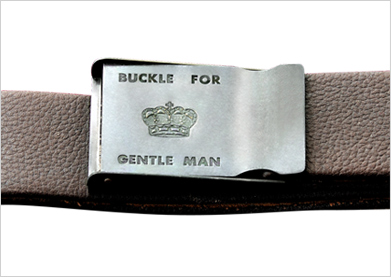
1915
Hayakawa Mechanical Pencil
Tokuji invented a unique thrusting device for a pencil's lead and inserted it into an attractive and sturdy metallic shaft. He called this product the Hayakawa Mechanical Pencil. At first, stationers had a number of criticisms: the metallic outer shaft was cold to the touch in winter, and the design clashed with the kimonos that were still widely worn at the time in Japan. But popularity jumped after a large order came in from a trading firm in Yokohama exporting to the West, and soon stationers in Japan were placing a steady stream of orders for the Hayakawa Mechanical Pencil. Tokuji improved the product by developing ultra-thin lead and he named this newer version the Ever-Ready Sharp Pencil. It became known simply as the Sharp Pencil, and the name lives on in our company name today.
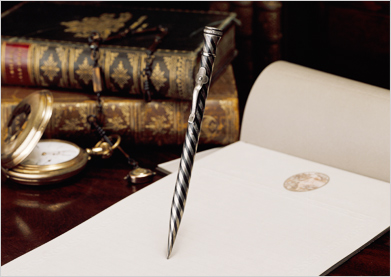
1925
Japan's First Crystal Radio
Following the Great Kanto Earthquake of 1923, Tokuji restarted business in Osaka, where he saw a future in the field of radio. In April 1925, he and his associates made history as they succeeded in assembling Japan's very first crystal radio.
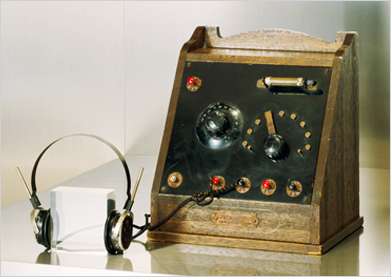
1929
Sharp Dyne AC Vacuum-Tube Radio
Radio technology advanced-from a crystal radio that only one person could listen to at a time via headphones to a vacuum-tube radio with a speaker that let everyone listen together. Sharp used the vacuum tube-design to develop a number of models with differing numbers of tubes and diverse styling. With its reliable reception under a variety of conditions, clear audio output, and high sound quality, the Sharp Dyne vacuum-tube radio satisfied a wide range of needs.
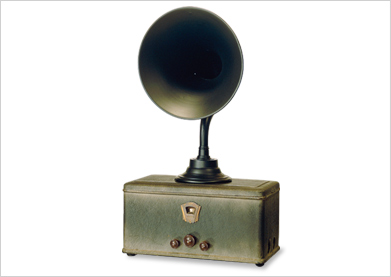
1953
Japan's First TV Set <TV3-14T>
The age of television in Japan began in 1953 when Sharp became the first Japanese company to mass produce TV sets. But Sharp's research into television goes back to 1931, a time when radios were just beginning to take off in Japan. Thanks to ultra-short wave technology gained from research during and after World War II, Sharp was able to build Japan's first TV set prototype in 1951. At the end of 1952, Sharp put Japan's first TV sets on the market and in 1953 became the first company in Japan to mass produce them. Sharp's first TV set, the TV3-14T, was priced at 175,000 yen-at that time the initial salary for high school graduates was 5,400 yen a month. With the goal of putting a TV set in every household, Sharp took the industry lead in bringing down costs so that this new appliance could be affordable to as many people as possible.
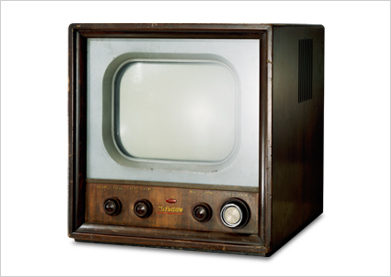
1960s


1962
Japan's First Mass Produced Microwave Oven <R-10>
Sharp developed the R-10, Japan's first microwave oven in 1961. The following year, Sharp became the first company to mass produce microwave ovens. It was generally believed that it would take some time for the general public to get used to the idea of cooking without a flame. Sharp was confident that someday microwave ovens would be a staple appliance in homes but in the meantime the company worked at creating a customer base by selling commercial-use microwave ovens.
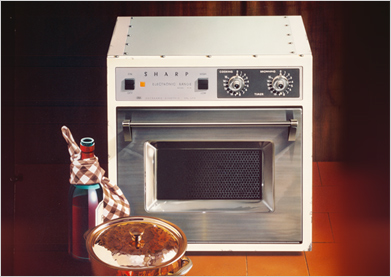
1963
Solar Modules
Sharp began research into solar power in 1959 and started mass production of standardized solar modules in 1963. At first, it was the Sharp engineers who worked at creating a market for solar modules. In May 1963, Sharp modules took on their first marine application as they were attached to a solar-powered lighted buoy in the Tsurumi Shipping Lane, Yokohama Port.
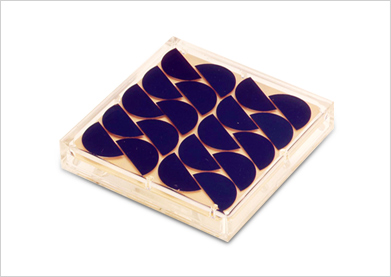
1964
All-Transistor-Diode Electronic Desktop Calculator <CS-10A>
The CS-10A was the world's first electronic desktop calculator using all-transistor diodes. It sold for 535,000 yen, about the same price as a 1,300 cc car. Four years earlier, in 1960, upon urging from young engineers at Sharp, the company had embarked on research into areas including computers and semiconductors. With the release in 1964 of the CS-10A, Sharp achieved its long-held goal of downsizing computers into a compact calculator that could be used by anyone, anywhere, and anytime. In December 2005, the electronic desktop calculator first commercialized by Sharp was recognized with a prestigious IEEE Milestone*1 from the IEEE*2, a worldwide electrical and electronics engineering society.
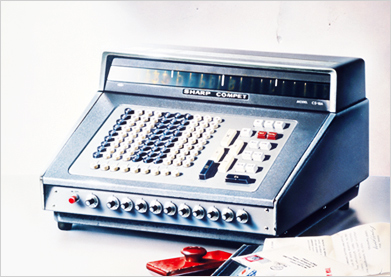
- *1
- The IEEE established the IEEE Milestone program in 1983 to honor significant achievements in the history of electrical and electronics engineering that have contributed to the betterment of society. Currently there are more than 100 Milestones around the world, including Volta's Electrical Battery Invention and the Fleming Valve. In Japan, the Directive Short Wave ("Yagi") Antenna (1995), the Mount Fuji Radar System (2000), the Tokaido Shinkansen ("Bullet Train") (2000), and the Electronic Quartz Wristwatch (2004) have been recognized.
- *2
- Institute of Electrical and Electronics Engineers (IEEE). The IEEE (pronounced "Eye-triple-E") is the world's largest non-profit, technical professional association of electrical and electronics engineers. Through its more than 377,000 individual members in approximately 150 countries worldwide, the IEEE plays a leading role in technical areas ranging from computer engineering, electronics, and telecommunications, to electric power, aerospace engineering, and biomedical technology, among others.
1966
Ogami Island Lighthouse in Nagasaki, Japan-Powered by Solar Cells
It was in 1959 that Sharp first succeeded in developing a prototype solar cell. In the years that followed, engineers continued their R&D work, improving durability and sunlight-to- electricity conversion efficiency and paving the way to commercialization.Solar cells have a long service life and can run without maintenance for long periods of time-qualities that led to the very first solar cell installation on an unmanned lighthouse on a remote island with no source of electricity.
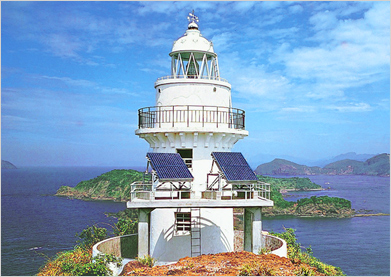
1966
Microwave Oven with Turntable <R-600>
In 1966, Sharp released the R-600, Japan's first microwave oven with a turntable. This revolutionary product eventually became the standard type to lead the industry.
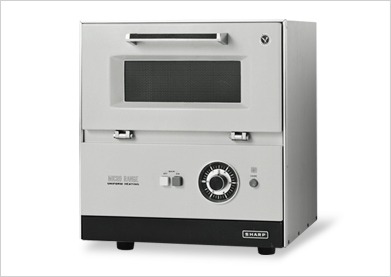
1969
Micro Compet-the World's First Calculator to Incorporate LSI Chips
North American Rockwell Corporation, a US company involved in the Apollo spaceflight effort, supplied the state-of-the-art LSI chip that Sharp needed to make an electronic calculator that could be held in the palm of one's hand. Sharp's Micro Compet calculator captured the world's attention with electronic technology born of the Apollo.

1970s


1973
Three-Door Refrigerator with Separate Vegetable Compartment <SJ-3300X>
To determine how to develop a refrigerator geared to the needs of Japanese households, Sharp conducted 20 surveys of 10,000 housewives nationwide. The result was the development of the SJ-3300X, a three-door refrigerator with a separate compartment especially for vegetables. Having vegetables in their own compartment helped keep them fresh longer.
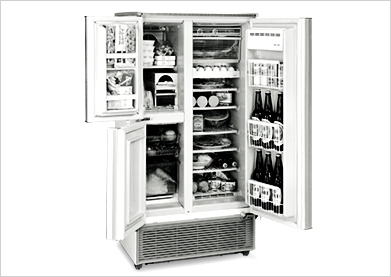
1973
World's First LCD Calculator <EL-805>
Thanks to the tireless efforts of Sharp's engineers, the company achieved the first practical application of LCDs. The EL-805 COS-type pocket calculator introduced in 1973 was the first product on the market to use LCDs. In December 2005, the EL-805 was one of the calculators recognized with a prestigious IEEE Milestone*1 from the IEEE*2.
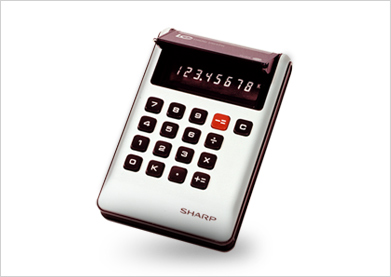
- *1
- The IEEE established the IEEE Milestone program in 1983 to honor significant achievements in the history of electrical and electronics engineering that have contributed to the betterment of society. Currently there are more than 100 Milestones around the world, including Volta's Electrical Battery Invention and the Fleming Valve. In Japan, the Directive Short Wave ("Yagi") Antenna (1995), the Mount Fuji Radar System (2000), the Tokaido Shinkansen ("Bullet Train") (2000), and the Electronic Quartz Wristwatch (2004) have been recognized.
- *2
- Institute of Electrical and Electronics Engineers (IEEE). The IEEE (pronounced"Eye-triple-E") is the world's largest non-profit, technical professional association of electrical and electronics engineers. Through its more than 377,000 individual members in approximately 150 countries worldwide, the IEEE plays a leading role in technical areas ranging from computer engineering, electronics, and telecommunications, to electric power, aerospace engineering, and biomedical technology, among others.
1978
Picture-in-Picture TV Set <CT-1804X>
In 1978, Sharp introduced the CT-1804X, the first TV in the industry allowing viewers to watch two programs at once on the same screen. Consumers enjoyed the new viewing style such as watching their favorite TV show while keeping track of a baseball game on another channel.
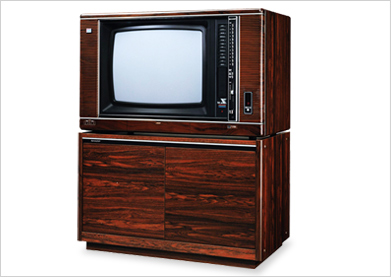
1979
Front-Loading VCR <VC-6080>
Sharp released several revolutionary VCRs; for example, a front-loading VCR that made it possible to place the VCR deck beneath a TV, and a VCR incorporating multiple functions thanks to the use of a microcomputer. The company also introduced an affordable VCR in the 150,000-yen price range, and Sharp's popular, user-friendly products helped it capture a double-digit share of the market.
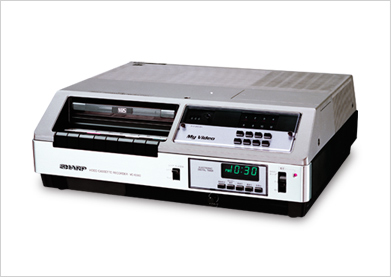
1979
Japanese Word Processor <WD-3000>
Following the successful development in 1977 of the industry first Japanese word processor prototype that received enthusiastic reviews at the Business Show, Sharp commercialized the product in 1979.At the time, the product adopted a stylus input method.
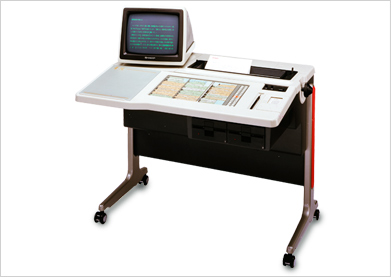
1979
Sensor Microwave Oven
Today, microwave ovens equipped with cooking sensors to detect doneness are commonplace, but in 1979, such sensors were an unknown cutting-edge technology.Sharp's microwave oven not only incorporated sensor technology to measure the degree of cooking doneness but also had cooking data derived from numerous cooking experiments and advice from first-class chefs embedded in the microcomputer that controlled the heating strength and time.
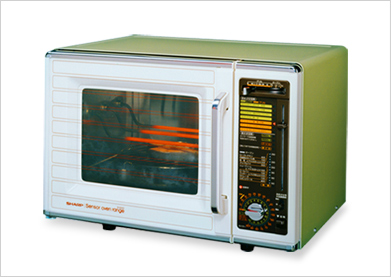
1980s


1981
Automatic Dual-Side Record Player
It was Sharp who changed the way vinyl records were played. With an optical sensor to monitor the record, a disc holder that allowed the record to be easily set in place, and accumulated microcomputer technology to control all of those operations, Sharp's record player made it possible to automatically enjoy all tracks on both sides of the disc without the cumbersome task of flipping the record over.
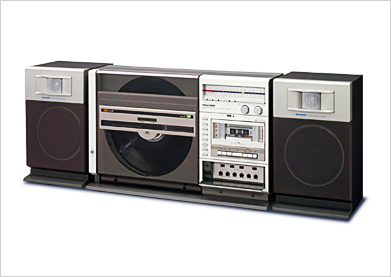
1982
PC-TV Set <X1>
Sharp created a buzz with the release of the X1 PC-TV set, the world's first product merging the personal computer and the TV. Not only could users either watch TV or do personal computing-they could display TV and PC images at once on the same screen.

1987
Electronic Organizer <PA-7000>
Sharp released the PA-7000 electronic organizer, a personal information tool allowing input of figures and text information. The product had kanji display capability and five major functions-calendar, memo pad, phone book, scheduler, and calculator-and could be expanded by inserting IC cards for specific applications. This hit product was perfectly timed for the dawn of a new information age.
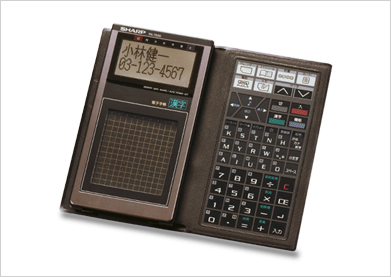
1987
Personal Word Processor with AI Dictionary
While Japanese word processors at the time converted typed alphabetic input into Japanese characters on a phrase-by-phrase basis, Sharp's featured an AI (artificial intelligence) dictionary to automatically convert text by interpreting input from the meaning of words and their context in sentences. This new consecutive-clause conversion was highly efficient and made smooth text input possible.
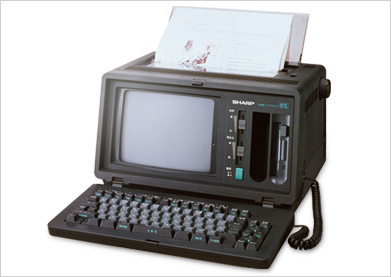
1988
14-Inch Color TFT LCD
By continuously building on the R&D efforts that had led to the introduction of the LCD pocket calculator in 1973 and by advancing technology developed for a three-inch LCD color TV, Sharp ultimately succeeded in producing a prototype 14-inch color TFT LCD. That development represented a significant milestone for Sharp LCD technology. In 1990, the Eduard Rhein Technology Award, referred to in Europe as the Nobel Prize of the AV world, was bestowed on this display.

1989
100-Inch LCD Video Projector
Video sources beyond conventional TV programming came onto the scene, and people began to enjoy a variety of content shown on home theater systems. This 100-inch LCD video projector was the world's first such product for home use that employed a system of LCD panels. It pioneered a new viewing style that let viewers enjoy a big screen matched to the size and layout of the room.
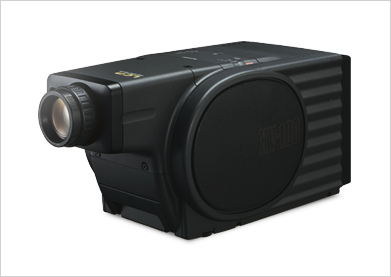
1989
Low-Power Cordless Phone with Answering Machine Function
At a time when consumer electronics and communications equipment manufacturers were competing in the growing market for cordless home phones, a Sharp purchaser's survey revealed that consumers wanted a cordless phone with an answering machine function. Sharp turned its attention to developing one and went on to introduce-ahead of the competition-a low-power cordless phone with an answering machine whose functions could be controlled away from the base unit via a distant handset.
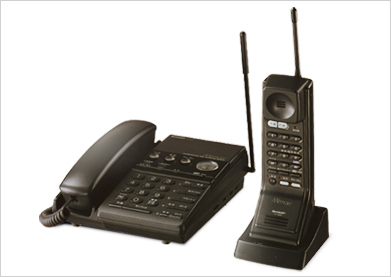
1989
Dual-Swing Door Refrigerator <SJ-38WB/32WB>
Sharp developers took inspiration from a broach pin to develop the SJ-38WB/32WB, a refrigerator that opens from either the right or left. Users loved how the product could be placed in any corner of the kitchen and opened without revealing the contents to guests.
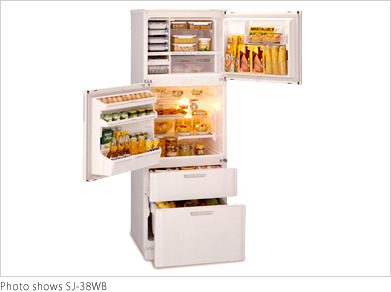
1990s


1990
Home-Use Facsimile <UX-1>
The UX-1 had features rivaling office facsimiles, like the ability to send and receive B4-sized paper and fast 15-second transmission time, all in a 2.8 kg product that was the world's thinnest at just 39 mm. By redesigning the conventional facsimile to create a new look for the home, the UX-1 was a hit.
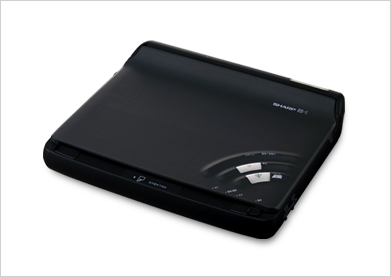
1991
Wall-Mount LCD TV
Sharp developed and introduced the world's first wall-mount TV, boasting an 8.6-inch color TFT LCD screen that was at that time the industry's largest. Coming in a number of designs to match different home interiors and providing high-quality images, the TV was lauded by the media for ushering in a new age of wall-mount TVs.
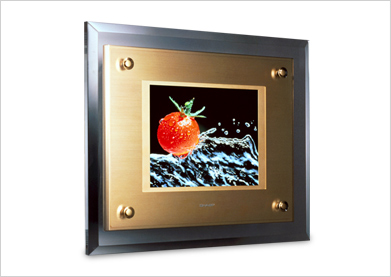
1992
LCD ViewCam <VL-HL1>
Sharp created a sensation with the introduction of the VL-HL1 LCD ViewCam, a video camera that replaced the conventional viewfinder with an LCD that users could watch while taking video. With never-before-seen features that included giving users the ability to enjoy their video on the spot and reverse the monitor in order to film themselves, the LCD ViewCam was a huge success.
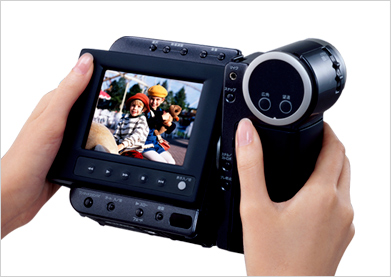
1992
Fully Automatic Washing Machine
Sharp developed a washing machine with a water-saving hole-less tub. Eliminating the drain holes in the spin-dry tub not only reduced the use of water and detergent, it also solved the problem of mold growing on the outside of the tub being transferred to the freshly laundered clothing inside. Sharp's washing machine earned a reputation for being a clean, environmentally friendly product.
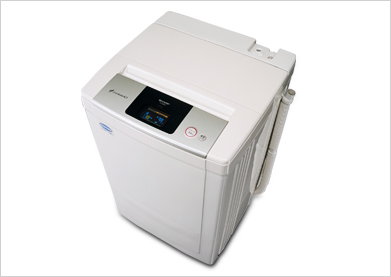
1993
The Smallest and Lightest Portable MD (MiniDisc) Player of Its Day
By employing a concurrent development system whereby R&D and design were undertaken simultaneously, and the transition to production coincided with the completion of development, Sharp was able to quickly launch its new portable MD player. Sharp's development of a compact hologram laser and an OPIC photodetector for use in the optical pickup that reads information from the MD achieved both smaller size and lighter weight and sent shockwaves through the industry.

1993
Zaurus Personal Information Tool <PI-3000>
The PI-3000 (nicknamed the Zaurus) was a new type of personal information tool that combined all the necessary business features into one. Subsequent models continued to evolve by incorporating features likes fax transmission, PC connection, and Internet access, in the process creating a whole new market and becoming one of Sharp's flagship products.

1997
Super Mobile LCD Eliminated the Need for a Backlight
While conventional transmissive LCDs used a backlight to make the display visible, the effects of sunlight made them rather difficult to see outdoors. And achieving a full-color display with conventional reflective displays was difficult. Sharp's Super Mobile LCD, however, didn't need a backlight and was perfect for outdoor use. In fact, the brighter the ambient light, the easier it was to see. With about one seventh the power consumption, one third the thickness, and about one half the weight of previous displays, it was the ideal LCD for mobile equipment.
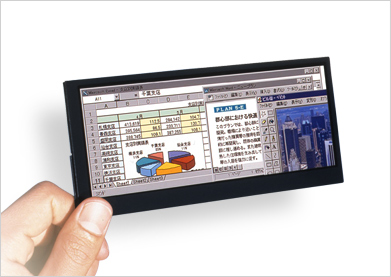
1999
World's First 1-Bit Amplifier
To convert an analog audio signal to digital form, 1-bit amplifier technology performs sampling at high speeds-approximately 2.8 million times per second, a rate 64 times faster than CDs. This sampling rate made it possible to reproduce sound as close to the original sound as possible.Because Sharp's 1-bit amplifier technology offered outstanding energy savings as well as high-quality sound and also made more compact equipment possible, Sharp went on to incorporate it into other AV equipment, such as AQUOS LCD TVs.
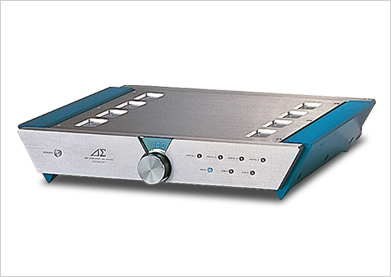
2000s


2000
Industry's First Camera-Equipped Mobile Phone <J-SH04>
The J-SH04 was the first mobile phone to feature a 110,000-pixel CMOS imager that allowed users to instantly e-mail photos they take. It was sold through Japanese carrier J-Phone.
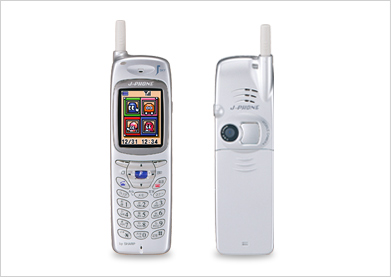
2000
Air Purifiers Using Plasmacluster Ion Technology <FU-L40X>
Sharp's proprietary Plasmacluster Ion technology gives off natural positive and negative ions using a plasma discharge. This suppresses the effcts of airborne viruses and breaks down and removes airborne mold fungi and other harmful substances. Sharp's FU-L40X was the first product on the market to utilize this technology.
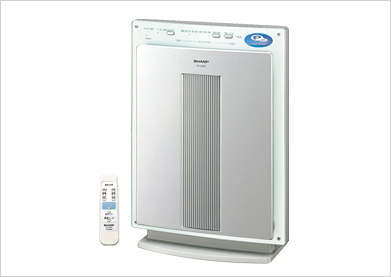
2001
AQUOS LCD Color TV <LC-20C1/15C1/13C1>
On January 1, Sharp released the LC-20C1/15C1/13C1 AQUOS LCD color TV, the ideal TV for the household of the 21st century. The first AQUOS boasted the industry's highest brightness of 450 cd/m² and a look created by renowned industrial designer Toshiyuki Kita to add elegance to the home.

2004
Superheated Steam Oven <AX-HC1>
Sharp's innovative AX-HC1 Superheated Steam Oven used a newly developed superheated steam generator to "roast" foods with water. By spraying food with superheated steam*1 at a temperature of 300℃, the oven delivered approximately eight times more heat content*2 than convection ovens. This cooked food such as meat and fried foods while dramatically reducing excessive fat and salt.This Superheated Steam Oven made possible a whole new level of healthy cooking, allowing low-calorie cooking that reduced fat in fried foods, low-salt cooking that reduced salt in foods such as salted fish, and low-oxygen cooking that limited the loss of nutrients such as vitamin C due to oxidization. The Superheated Steam Oven won over countless consumers looking for a healthy way to cook.
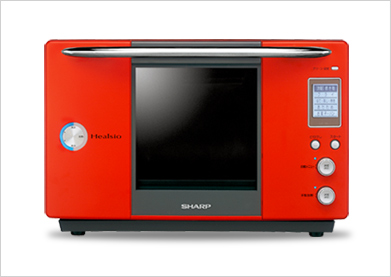
- *1
- A clear, colorless gas obtained by heating ordinary steam at 100℃ under normal pressure to even higher temperatures.
- *2
- Compared to the heating capacity per cubic meter (m3) of Sharp's RE-MA1 convection/microwave oven when the oven is cooking at 230℃.
2005
65-Inch Digital Full-HD LCD TV <LC-65GE1>
The world's largest when released, Sharp's 65-inch full-HD LCD TV caused a sensation. It employed a full-HD LCD panel that displayed high-definition signal images 'as is'. With technologies such as quick response speed for sports and other fast-moving images, this Sharp LCD TV allowed viewers to be entertained in unprecedented clarity.And Sharp's four-wavelength backlight system, which complements blue, green, and red with 'deep red', enabled more faithful reproduction of the pure red color.
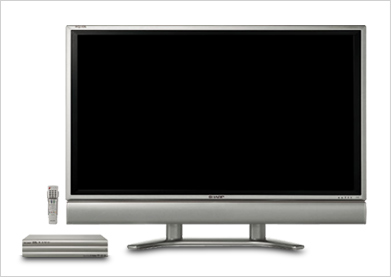
2006
AQUOS Phone <905SH>
Sharp's 905SH AQUOS Phone from carrier Vodafone was compatible with One-Seg mobile terrestrial digital broadcasts. The phone featured Sharp's Cycloid*-style 90-degree rotating screen, an industry first for watching television in widescreen horizontal view. Another industry first was the ability to talk on the phone and do e-mail while watching television. With the April 2006 start of One-Seg mobile broadcasts ushering in an era of on-the-go TV and image viewing, the 905SH became an instant hit by putting the beautiful reception of Sharp's renowned AQUOS LCD TV technology into people's hands wherever they went.
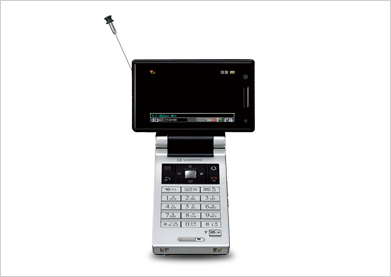
- *
- Cycloid is a registered trademark of Sharp Corporation.
2008
108-Inch LCD Monitor <LB-1085>
Sharp released the LB-1085 commercial-use 108-inch LCD monitor, the world's largest at the time*. Each monitor's ASV (Advanced Super View) panel was made from one eighth-generation glass substrate (measuring 2,160 x 2,460 mm) at Sharp's state-of-the-art Kameyama Plant No. 2. The huge screen measuring approximately 3.2 m2 meant that information could be conveyed to large numbers of people in large spaces.
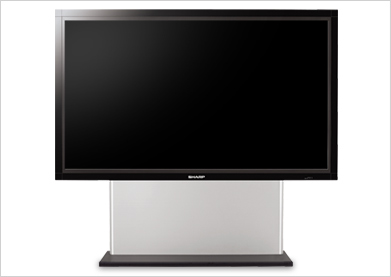
- *
- As of June 13, 2008, for commercially available direct-view LCD monitors.
2008
AQUOS LCD TV with Built-In Blu-ray Disc Recorder <LC-52DX1>
Sharp introduced the world's first TV with a built-in Blu-ray Disc recorder*. The LC-52X1 series expanded people's home entertainment horizons as they now had the ability to watch TV, play Blu-ray Discs and DVDs, and record TV programs in high definition onto a Blu-ray Disc. Having all these functions in one unit eliminated complicated cable connections and simplified operations for TV viewing, recording, and playback operation onto on remote controller.
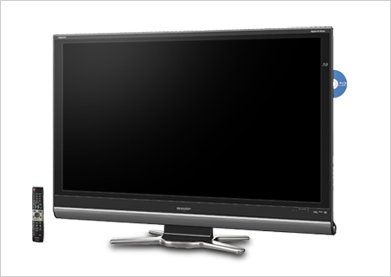
- *
- As of October 15, 2008 for digital HD LCD TVs with built-in Blu-ray Disc recorders.
2009
LED Lamp <DL-L60AV>
Sharp released the DL-L60AV LED lamp featuring a remote controller for changing the color of the light, an industry first*. Users could select their preferred shade of white according to the weather, season of the year, or time of day; for example, warm white during the winter or at dinnertime when a relaxing atmosphere is desired, or a crisp cooler daylight white during the summer or in the morning for a refreshing wake-up. And combining this with the dimmer function, users could adjust lighting to the color and brightness they desired with one remote controller.
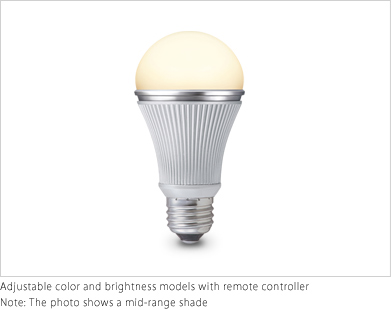
- ※
- As of June 11, 2009 for LED lamps having nearly the same physical size and shape as a standard incandescent lamp used for general illumination.
2010

2010
Multi-Screen Display System
Sharp announced a multi-screen display system with the world's thinnest system frame width of 6.5 mm*, making the seams between adjacent monitors inconspicuous and expanding the potential for digital signage. The LCD monitor for this display system featured an LED backlight that reduced areas of uneven brightness in multi-screen configurations.
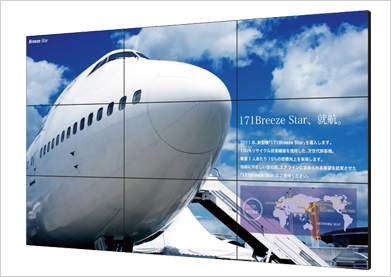
- *
- For the 60-inch PN-V601 LCD monitor; world's thinnest frame width for LCDs 46 inches and larger as of June 7, 2010.
2010
AQUOS Quattron 3D TV <LC-60LV3><LC-52LV3><LC-46LV3><LC-40LV3>
Sharp introduced the LV Series AQUOS Quattron 3D LCD TVs, which use four-primary-color*1 3D LCDs, a world first*2. Developed based on Sharp's proprietary UV2A technology*3, this technology adds Y (yellow) to the three RGB (red, green, blue) primary colors.AQUOS Quattron gives vivid reproduction of colors such as brilliant yellow, brassy gold, and emerald green, colors difficult to achieve faithfully with conventional three-primary-color technology. In addition, increased light utilization efficiency provides a level of brightness approximately 1.8 times greater*4 than three-primary-color LCD panels, enabling users to enjoy breath-taking images. Further, proprietary Sharp technology gives life-like images with dramatically reduced crosstalk.
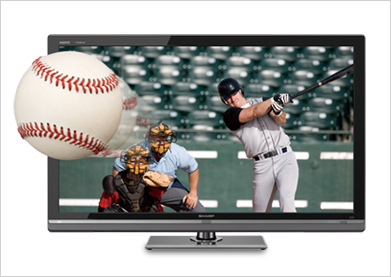
- *1
- Four-primary color is a proprietary Sharp technology for reproducing colors on a display; it differs from the conventional three-primary-color concept of light and color.
- *2
- As of April 12, 2010; for commercially available LCDs for 3D TV.
- *3
- Acronym for Ultraviolet induced multi-domain Vertical Alignment. Photo-alignment technology that can precisely control the alignment of liquid crystal molecules using a manufacturing method based on UV light exposure.
- *4
- Screen brightness when displaying 3D images compared to Sharp's previous technology (three-primary-color Advanced Super View LCD without FRED technology).
2010
GALAPAGOS Media Tablet
To give users a new experience based on a network service and terminal devices optimized for that service, Sharp inaugurated a cloud media service business called GALAPAGOS. After debuting its e-bookstore service and two models of its dedicated media tablet, Sharp went on to develop GALAPAGOS even further, extending the application fields beyond e-books to evolve with the changing needs of customers.

2010
LED Ceiling Lights
Shortly after releasing a line of LED lamps, Sharp introduced the industry's first* LCD ceiling lights, designed to serve as the new main lighting in homes. Along with a thin design made possible by Sharp's proprietary light diffusion technology, these lights featured dimming and color adjustment functions, which combined to offer 110 different levels of color and brightness, and energy-saving eco functions.
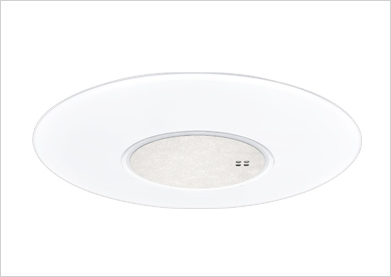
- *
- As of August 19, 2010, for LED ceiling lights with a luminous flux of at least 2,000 lumens, compatible with JIS-standard ceiling rosettes (ceiling wiring sockets); based on Sharp research.
2011

2011
Freestyle AQUOS
Sharp released the Freestyle AQUOS, a TV that users can easily set up in their preferred location at home. Wireless transmission means no antenna complications and the ability to enjoy TV and Internet in every room.
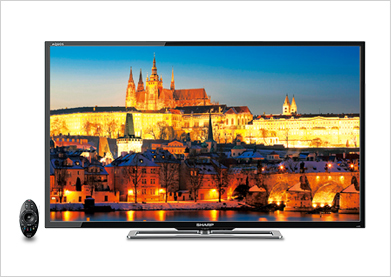
2011
Interactive Whiteboard <PN-L702B> <PN-L602B>
Sharp released the PN-L702B/602B interactive whiteboard with touchscreen display capable of showing still or moving images, as well as PC screens, in amazingly high resolution. The bundled application software gives easy touch operation, allowing users to write notes directly onscreen with a stylus or finger, zoom in or out, and flip through pages. By hooking the interactive whiteboard up to a Sharp multi function printer, users can print out the whiteboard's screen contents, scan documents to show on the big screen, and even write notes over top of onscreen data. Sharp's interactive whiteboard is a business communication tool that can boost work efficiency in so many ways.
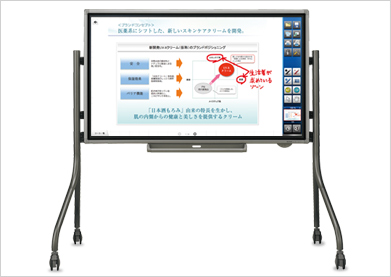
2012

2012
Sakura-Colored LED Light
Sharp developed a sakura (cherry blossom)-colored LED light. Test results* have shown that pale-pink light is effective in providing a sense of healing and in contributing to sound sleep. Along with cool-white light and warm-white light, found on Sharp’s conventional LED ceiling lights, these lights provide two types of cherry-blossom-pink light—yaezakura (a richer pink) and somei-yoshino (a lighter pink). After bathing in pale-pink light for approximately one hour before going to bed, users can get a sense of healing and are likely to fall asleep easily and wake up feeling refreshed.
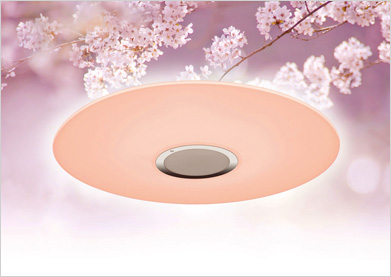
- *
- The use of these pale-pink LED lights is not intended to guarantee prevention or alleviation of mental stress, or improvement in quality of sleep. Actual results will vary depending on the person and on the usage environment.
2012
RX-V100 Robotic Cleaning Appliance
Sharp embarked on the development of robotic home appliances that bring comfort and peace of mind to daily life through advanced functions. The first such appliance was the RX-V100, a room-cleaning robot equipped with a high-concentration Plasmacluster Ion generator. Artificial intelligence allows the RX-V100 to react to things such as its battery level and the room’s cleanliness, and voice-recognition technology* allows it to communicate with its owner. The RX-V100 moves around freely in a room and cleans it up for you.
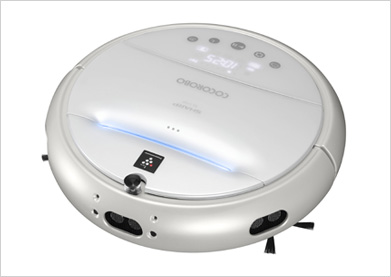
- *
- This product employs a voice-recognition engine from Ray Tron Co., Ltd.
2012
Rice Cooker
Sharp released a unique rice cooker minimizing inconsistencies in rice rinsing and rice cooking this year. This rice cooker cooks healthy, delicious rice. An industry-first* stirrer unit designed under a biomimetic concept creates an ideal flow of water that stirs rice effectively while preventing the rice from scattering and colliding against the cooker's inner bowl. The result is full, fluffy, delicious rice.

- *
- As of October 1, 2012, for home-use induction-heating rice cookers for the Japanese market.
2012
Docomo NEXT Series AQUOS Phone Zeta SH-02E IGZO Smartphone
The SH-02E is the first smartphone in the industry*1 to be equipped with the next-generation IGZO display, which boasts extraordinarily high resolution and improved energy efficiency. Thanks to IGZO's outstanding energy efficiency, this smartphone's battery can last approximately 4.8 times longer than that of previous models*2 (for continuous display of still images). You can use the smartphone for two days*3 without worrying about the battery running out.
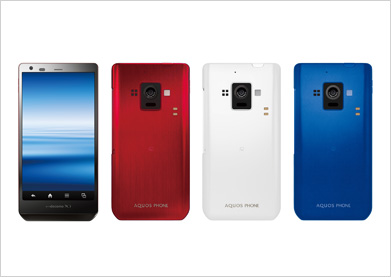
- *1
- As of November 26, 2012, for smartphones available on the Japanese market; based on Sharp research.
- *2
- Compared to Sharp SH-01D.
- *3
- Measured by Sharp based on assumed conditions of usage (e.g., sending/receiving e-mails, using apps). May vary greatly depending on factors such as how apps are used and the network environment.
2013

2013
ICC PURIOS
The ICC Purios employs ICC (Integrated Cognitive Creation)*1, a “visual creation” technology from I3 (I-cubed) Research Center Inc.*2, and a 4K panel with 8.29 million pixels (3,840 x 2,160), four times*3 that of full HD. This LCD TV also has panel control technology for fine-tuning of brightness.
These features combine to give scenery images a realistic perspective and objects a 3D feel, making viewers almost feel like they are part of the on-screen world. They also result in meticulous reproduction of images with a consistent brightness exceeding that of standards for commercial master monitors used at TV stations and in other professional settings.
The ICC Purios was the world’s first TV certified for the THX 4K Display standard*4 stipulated by THX Ltd.*4. It’s a premium model for consumers who demand an authentic home theater experience and images second to none.

- *1
- Technology for making HD images even more life-like and detailed.
- *2
- Based in Setagaya-ku, Tokyo; President: Tetsujiro Kondo
- *3
- Compared to full HD (1,920 x 1,080). ICC Purios model: 3,840 x 2,160.
- *4
- World’s first conformance (December 13, 2012) to THX 4K Display certification. THX is a registered trademark of THX Ltd.
2013
UD1 Series AQUOS 4K TV
This AQUOS brand 4K-compatible LCD TV employs the 4K Moth Eye®*1 panel and the AQUOS 4K-Master Engine Pro, a new image processing circuit.
Employing the 4K Moth Eye panel gives incredibly detailed images with 8.29 million pixels, four times*2 the resolution of full HD. It also achieves evenly distributed and consistently high brightness and displays images with gradation faithful to the input signal.
The panel also reduces on-screen reflection from outside and room light to give rich, deep blacks and highly viewable images that are vivid right down to the smallest details.
With the AQUOS 4K-Master Engine Pro for upscaling full-HD images to 4K resolution, viewers get terrestrial digital broadcasts and Blu-ray Disc images in super-detailed, life-like 4K resolution.

- *1
- Moth Eye technology represents an application of a phenomenon occurring in nature. Based on research into the structure of moth eyes, which do not reflect moonlight, moth-eye-like nanostructures are formed on film to prevent it from reflecting ambient light. Moth Eye is a trademark and registered trademark of Dai Nippon Printing Co., Ltd. The 4K Moth Eye panel is an ultra-high-definition Moth Eye panel compatible with 4K.
- *2
- Compared to full HD (1,920 x 1,080). ICC Purios model: 3,840 x 2,160.
2013
Microbe Sensor
Sharp developed a microbe sensor that can automatically measure the amount of airborne microbes, such as bacteria and mold spores, in as little as 10 minutes*1.
The sensor takes in air from the measuring area and extracts the microbes that need to be detected. Using Sharp’s proprietary version of the fluorescent detection method*2, it automatically measures the amount of microbes in as little as 10 minutes. The microbe sensor can be linked to a computer to conduct continuous measuring, making it possible to monitor changes in microbe counts over time*3.
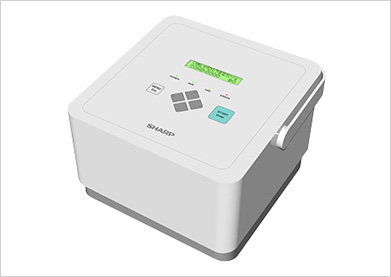
- *1
- Measurement time will vary depending on factors such as the amount of microbes and the measurement environment.
- *2
- Microbes give off fluorescent light when subjected to a certain wavelength of light, making it possible to measure the amount of microbes.
- *3
- The monitored data is compiled by a PC or other device that the sensor is connected to.
2014


2014
Healsio Ocha-Presso Tea Machine
Sharp released the Healsio Ocha-Presso tea machine, which makes green tea without altering*1 the nutrient*2 content of tea leaves such as catechin*3 and fiber. It represents a whole new way to make and enjoy green tea.
The product’s small ceramic tea mortar mills the tea leaves into a fine powder, doing it slowly in order to reduce friction heat and thus avoiding the destruction of the nutrients in the leaves. While in conventional tea brewing the leaves end up as leftover tea grounds, the leaves themselves are ground into a fine powder with Sharp’s Ocha-Presso. The result is green tea that not only has approximately 1.9 times*4 the amount of catechin but is also high in nutrients such as fiber and chlorophyll*5, something rarely found in tea-pot-made green tea. The milled tea leaves are stirred with a rotary blade—like as with a bamboo whisk—inside the machine, then mixed evenly with hot water to give the flavor of authentic, hand-made green tea.
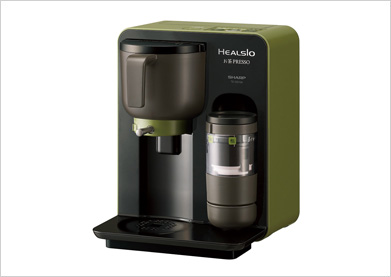
- *1
- When milling tea leaves for one to three people at one time.
- *2
- Nutrients in green tea include vitamins A, C, and E, catechin, fiber, chlorophyll, theanine, and caffeine.
- *3
- Catechin is an effective antioxidant and can also lower blood cholesterol and blood sugar levels.
- *4
- Tests conducted by Japan Food Research Laboratories; test results published on February 21, 2014; test results publication number 14012819008-01; amount of catechin was measured by Sharp.
- *5
- Chlorophyll is a nutrient with effects that include deodorizing.
2014
UD20 Series AQUOS 4K TV
Sharp released the UD20 series of 4K-compatible LCD TVs, which give consumers powerful, life-like images and allow viewing in original resolution of 4K trial broadcasts*1, an industry first*2, and 4K Internet streaming videos.
To watch 4K trial broadcasts (4K 60p), a TV needs to comply with the HDMI 2.0 standard (4K 60p) for digital image transmission, be compatible with the HDCP 2.2 copy protection standard, and have a tuner capable of receiving 4K trial broadcasts. In addition to satisfying both these standards, the UD20 can be combined with the AQUOS 4K recorder (released simultaneously), the first 4K recorder in the industry*2 capable of receiving 4K trial broadcasts and thus allowing home users enjoyment of these broadcasts. As well, the UD20 series is the industry’s first*2 TV to come with an HEVC decoder*3 compatible with Hikari TV 4K video on demand, a service presented since October 27, 2014 by NTT Plala Inc., enabling users to enjoy 4K broadcasts with just this TV.
Sharp’s 4K low-reflection panel reduces on-screen reflection of ambient light and provides rich, deep blacks, while Sharp’s Rich Color Technology expands the color gamut by 12% compared to a previous models*4, thus providing high-resolution, highly detailed 4K images in brilliant colors.
As for sound quality, the UD20 series comes with a newly developed sound bar, which is detached and independent of the display. With the left and right rounded dual mid-range speakers and tweeters placed facing frontwards, users get high output and balanced sound. At the rear of the display is a DuoBass low-vibration subwoofer, which increases the realistic audio experience of the 2.1-channel, three-way, eight-speaker system.
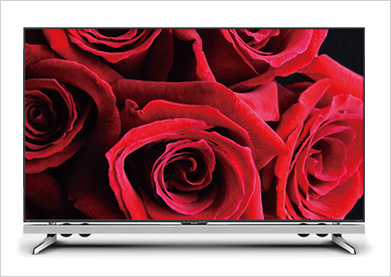
- *1
- 4K trial broadcasts were begun in June 2014 by the NexTV-F (Next Generation Television & Broadcasting Promotion Forum) on a dedicated, no-fee channel on 124/128° CS digital broadcasting in Japan. It is not a SKY PerfecTV Premium Service channel. To watch these broadcasts, users require a UD20 series TV, AQUOS 4K recorder (TU-UD1000), a SKY PerfecTV IC card, a SKY PerfecTV Premium Service-compatible antenna, and a viewing subscription (free of charge).
- *2
- As of May 20, 2014; for a 4K recorder or 4K-compatible TV.
- *3
- A decoder compatible with the HEVC (high-efficiency video decoding) compression standard for 4K video-on-demand transmissions from Hikari TV.
- *4
- Compared to Sharp UD1 series 4K-compatible LCD TVs (released in 2013); Sharp data.
2014
TU-UD1000 AQUOS 4K Recorder
Sharp’s TU-UD1000 AQUOS 4K recorder can receive, record, and play back 4K trial broadcasts*1 (4K 60p) in their original resolution, an industry first*2.
In June 2014 in Japan, the NexTV-F (Next Generation Television & Broadcasting Promotion Forum) began broadcasting 4K trial broadcasts on 124/128° CS digital broadcasting, but to watch these broadcasts users require a compatible HEVC decoder*3 and a tuner for SKY PerfecTV’s Premium Service.
The TU-UD1000 has an HEVC decoder and a tuner for SKY PerfecTV’s Premium Service, allowing users to receive 4K trial broadcasts in their original resolution. By combining this product with a 4K-compatible AQUOS TV*4, users can enjoy high-resolution 4K entertainment.
The TU-UD1000 has a 1TB hard disk for storage of approximately 53 hours*5 of 4K broadcasts in DR mode. It is also compatible with the HDMI 2.0 standard (4K 60p) for digital image transmission and the HDCP 2.2 copy protection standard, which means that users can play back the 4K trial broadcast images (in 4K 60p) in their original 4K resolution.

- *1
- 4K trial broadcasts were begun in June 2014 by the NexTV-F (Next Generation Television & Broadcasting Promotion Forum) on a dedicated, no-fee channel on 124/128° CS digital broadcasting in Japan. It is not a SKY PerfecTV Premium Service channel. To watch these broadcasts, users require, in addition to the TU-UD1000 AQUOS 4K recorder, a 4K-compatible TV (HDCP 2.2 compatible) or a Sharp AQUOS Quattron Pro (XL10 series), a SKY PerfecTV IC card (comes with the TU-UD1000), a SKY PerfecTV Premium Service-compatible antenna, and a viewing subscription (free of charge).
- *2
- As of May 20, 2014; for a 4K recorder.
- *3
- A decoder compatible with the HEVC (high-efficiency video decoding) compression standard for 4K trial broadcasts.
- *4
- If using the AQUOS LC-70UD1 or LC-60UD1 TVs, the TV’s software needs to be updated.
- *5
- Number of hours of 4K trial broadcasts at 40 Mbps. Note that the actual number of hours that can be recorded will be greater or less than this number depending on the quality of the images recorded and other factors.
2014
Cloud Storage Battery System
The JH-WB1401 and JH-WB1402*1 cloud battery storage systems combine with Sharp’s cloud HEMS*2 to realize efficient energy management by adapting to changes in the usage environment.
With this new energy solution from Sharp, the system predicts how much power will be generated based on the next day’s weather forecast and analyzes the user’s daily power usage situation, in the process automatically controlling battery charging and power supply in the most optimal way and reducing electricity bills.
The cloud storage battery comes in two types: one for installation indoors for cold regions*3, and another for outdoor installation. It is also much more compact than Sharp’s previous storage battery*4. And while Sharp’s previous product required two power conditioners—one for the solar power generation system and one for the storage battery system—the JH-WB1401 and JH-WB1402 require only one power conditioner, allowing for efficient charging.
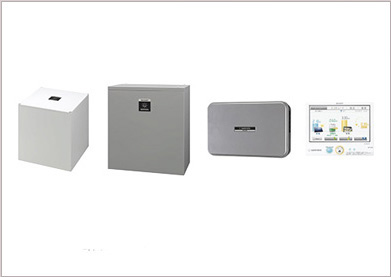
- *1
- These are the model names of the storage batteries only. To constitute a storage battery system, the JH-42EM2P power conditioner and JH-RWL6V multi-energy monitor are also required.
- *2
- The JH-RTP4 and JH-RTP5 cloud HEMS (home energy management systems). The JH-RTP4 went on sale (in Japan) on July 4, 2014 at a suggested retail price (excluding tax) of 74,000 yen and the JH-RTP5 went on sale (in Japan) on July 4, 2014 at a suggested retail price (excluding tax) of 75,000 yen. Also required for the system are a broadband router, a broadband Internet connection, and membership in the Sharp iClub.
- *3
- Operating temperature range: 0℃–40℃. The JH-WB1401 is for cold regions.
- *4
- Compared to Sharp’s JH-WB1201.
2014
Emopa-Equipped Smartphones
Sharp released smartphones equipped with Emopa, a newly developed function that, for example, gives the user audio and text messages, and changes the screen, depending on the time, place, and user's personal needs. The smartphones have been released in models for three major Japanese mobile phone carriers*. The word "Emopa" stands for "emotional partner." The technology incorporated into Sharp's newly released smartphones is based on the Cocoro Engine artificial intelligence used in Sharp's health and environment appliances. Adapting to a range of situations, Emopa knows what the user needs to hear as it gives suggestions regarding what to do next, in the process offering both friendship and comfort. For example, when the user is about to leave home, Emopa's voice will say "Don't forget your umbrella" if the weather forecast calls for rain. Such well-timed messages give the phone a heart and soul and make possible a whole new world of communications between people and their smartphones.
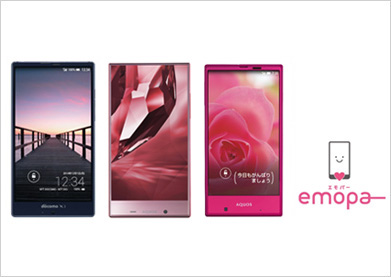
- *
- AQUOS Zeta SH-01G for NTT Docomo, AQUOS Crystal X for SoftBank, and AQUOS Serie Mini SHV31 for KDDI. The KDDI model will be released before the end of 2015.
2014
Infrared Color Night-Vision Security Camera
Sharp developed and released for commercial use the LZ0P420A infrared color night-vision camera, the first product of its kind in the industry*1 that allows video capture in zero-lux settings.
This product employs a CCD*2 jointly developed by Sharp and the National Institute of Advanced Industrial Science and Technology (AIST). By irradiating objects with near-infrared rays, smooth color video can be captured even in settings of zero lux—in other words, pitch-dark settings.
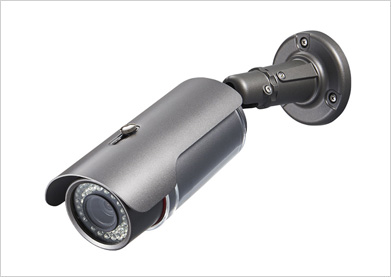
- *1
- As of November 4, 2014; for infrared color night-vision cameras using a single-sensor (one-chip CCD) system supporting HD 720 (1280 x 720 pixels) and 30-fps video capture. Based on Sharp research.
- *2
- This camera's night-vision image sensor (CCD) is based on color night-vision technology developed by AIST (announced by AIST on February 8, 2011 and December 3, 2012). The image sensor (CCD) was developed jointly by Sharp Corporation and AIST (announced by AIST on May 14, 2014).
2014
Ceiling-Installed Plasmacluster Ion Generator
Sharp released the IG-GTA20 ceiling-installed*1 Plasmacluster Ion generator, which includes an LED light and deodorizes and eliminates*2 odor-causing bacteria adhering to the floor and other places in the bathroom.
The Plasmacluster Ion generator draws its power by attaching into a standard-sized E26 cap shape light socket. This means that deodorizing and eliminating odor-causing bacteria from the bathroom, one of the most worrisome rooms in the house for unpleasant odors, is as easy as screwing in a light bulb. It also means it fits inconspicuously into bathrooms that have no extra wall outlets or extra space for installing Plasmacluster Ion generators.
A motion sensor turns on and off the generator's LED light when someone enters and leaves the bathroom. When the bathroom is empty, the light is turned off and Plasmacluster Ions are generated in maximum mode. And when someone enters the bathroom, the light goes on again and the generator automatically returns to standard mode with a lighter airflow. So there's no need to worry about forgetting to turn off the bathroom light, and users get round-the-clock deodorizing for an electricity cost of approximately 1.8 yen*3 per day.

- *1
- For screwing into E26 cap shape light socket on ceiling.
- *2
- Elimination of bacteria: Effect after seven days in a test space of approximately 3.4 m³; not a proven result in actual usage space.
- *3
- For two hours of standard mode operation (LED light on) and 22 hours of maximum mode operation (LED light off) per day. Calculation is a rough estimate based on a unit cost of 27 yen/kWh (including tax) under the latest electricity rates in Japan. There will be additional electricity costs for the bathroom ventilation fan if it operates in unison with the light switch.
2015

2015
Cornet Cyclonic Vacuum Cleaner for Bedding
Sharp released the EC-HX100 Cornet cyclonic vacuum cleaner for bedding, the first vacuum cleaner in the industry*1 to employ a heat cyclone that takes advantage of mites'*2 weakness against heat by blowing warm air onto bedding to loosen mites' grip from the fibers of bedding and then powerfully sucking them up.
The Cornet removes*3*4 mites and related allergens (mite feces and mite carcasses) from bedding by using a powerful beating brush, along with heat generated by the motor that is blown as warm air onto the bedding to loosen the mites' grip from the fibers so that they can be sucked up by the powerful vacuum force. The warm air comes from the vacuum cleaner's internal motor to save on electricity consumption. There is also a function to prevent the air temperature from getting too high and damaging the bedding.
More than 99% of the mites sucked up are killed*5 by the high-speed swirling air movement of the centrifugal separation cyclone motor. Cleaning of the dust cup and filter is easy: just remove them and wash them with water. In addition, the warm air and Plasmacluster Ions deodorize*6 pillows and other bedding, while the warm air also fluffs up the bedding to a comfortable softness.

- *1
- For household electric vacuum cleaners sold in Japan. Equipped with a system to blow air warmed utilizing heat from the interior of the unit out from the bottom of the unit and to apply suction using cyclonic action. As of May 21, 2015. Based on Sharp research.
- *2
- House dust mites
- *3
- Test institute: Viable Co., Ltd.; Test method: House dust mites were spread over bedding and sucked up with the Cornet; Test result: More than 99% removed. Note that not all mites were removed from bedding.
- *4
- Test institute: Biostir Inc.; Test method: Impurities mixed with allergens containing mite feces and mite carcasses were spread over bedding and sucked up with the Cornet; Test result: More than 99% removed. Note that not all allergens were removed from bedding.
- *5
- Test institute: Viable Co., Ltd.; Test method: Live house dust mites were spread over bedding and sucked up with the Cornet, and the percentage of dead mites in the dust cup was measured; Test result: More than 99% dead.
- *6
- Test institute: Sharp Corporation: Test method: The Cornet was moved slowly (at a speed of 10 cm/sec) back and forth once over bedding infused with an odor component (nonenal) contained in the body odor of old persons and in other body odors. The deodorizing effectiveness was evaluated by a six-level odor intensity indication method; Test result: Odors reduced to an unnoticeable level. Note that deodorizing effectiveness will vary according to the type and strength of the odors, the material onto which odors are affixed, and the speed at which the vacuum cleaner is moved over the bedding.
2015
AQUOS 4K Next 4K LCD TV
Sharp released the AQUOS 4K Next 4K LCD TV, with a 4K LCD panel employing Sharp's proprietary 4-color*1 technology for combining red, green, blue, and yellow sub-pixels to enable 8K-equivalent resolution*2, as well as the world's first*3 8K upscaling circuit for rendering 8K images.
The AQUOS 4K Next delivers beauty down to the most minute details thanks to the 8K upscaling circuit embedded into the X8-Master Engine Pro. This works in unison with Sharp's Rich Color technology, consisting of an LED backlight system employing a new fluorescent material and a color restoration circuit, to achieve approximately 1.4 times the color reproduction range of previous Sharp TVs*4.
The AQUOS 4K Next includes Megacontrast dynamic range expansion technology, which boosts the ability to express light and dark shades by simultaneously controlling the LCD openings and the brightness of each area of the backlight using a proprietary algorithm that detects and restores the brilliance of the light source and the shine reflecting off the light source of the image. Through Sharp's proprietary low-reflective N-Black Panel, and other high-image-quality technologies that enable superb detail, a rich color gamut, and high contrast, the AQUOS 4K Next literally puts television viewers inside the onscreen action.
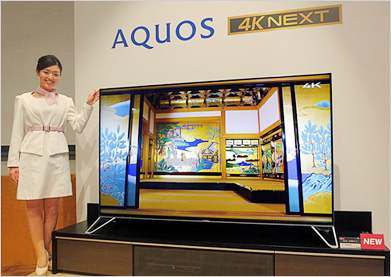
- *1
- Sharp's 4-color concept was designed for use with displays; it differs from the conventional three-primary-color concept of light and color.
- *2
- Evaluation of the resolution of a brightness signal manipulated by Sharp using a 7,680 (H) x 4,320 (V) resolution chart. Not compatible with external device input of 8K resolution (video) or receiving of 8K broadcast.
- *3
- As of May 21, 2015; for commercially available 4K LCD TVs with an 8K upscaling circuit.
- *4
- Compared to Sharp's LC-40H20 HDTV (released in February 2015).
2015
Tuly Robot
The Tuly Robot, developed jointly by Sharp and Huis Ten Bosch Co., Ltd., has been installed in rooms at the Henn-na Hotel* ("Strange Hotel"), a smart hotel at the Huis Ten Bosch theme park in Sasebo, Nagasaki Prefecture. The hotel opened on July 17, 2015.
Tuly is the mascot of Huis Ten Bosch, and a lamp-sized Tuly Robot sits on a bedside table in each of the hotel's rooms, acting as a personal concierge to make guests' stay as comfortable as possible.
Sharp also provided the Henn-na Hotel with porter robots that guide guests to their rooms and carry luggage.

- *
- Henn-na Hotel address:
6-5 Huis Ten Bosch-cho, Sasebo-shi, Nagasaki Prefecture, Japan
(Opened to the public on July 17, 2015.)
2015
Digital Cordless Facsimiles and Phones with Functions for Helping Prevent Bank Transfer Swindling
Sharp released two models of digital cordless facsimiles, the UX-AF90CL and UX-AF90CW, and two models of digital cordless phones, the JD-AT80CL and JD-AT80CW, which have functions for helping prevent bank transfer swindling (in which callers trick people into depositing money into a bank account).
There are seven functions useful in preventing bank transfer swindling over the phone. These include functions that warn users about incoming calls before they answer. With one function, for incoming calls from numbers not registered in the main phone unit's database, the phone automatically switches to a voice message asking the caller to give his or her name. The user will also be notified of incoming calls from unregistered numbers with a flashing red LED lamp*1.
An automatic call recording function*2 records an entire phone conversation after giving a warning message that it is about to do so. These facsimiles and phones are also easy to use, thanks to features like a large LED screen and a button for increasing receiver volume so callers are easy to hear.
Sharp also released two models of digital cordless facsimiles, the UX-AF91CL and UX-AF91CW, which have the industry's first*3 function for filtering incoming calls by automatically discriminating calls and blocking ones that are suspicious.
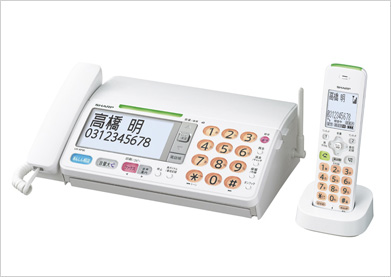
- *1
- Users must sign up for caller ID (fee-based service) to use this function.
- *2
- When signing up for caller ID service, the user can choose to play the warning message with this function only for incoming calls from numbers not registered in the phone's database. Registered numbers refer to the following: numbers registered in the main phone unit (not the cordless handset), in the one-touch dial database (only on the JD-AT80), in the Peace-of-Mind Consultation database, and in the Peace-of-Mind database.
- *3
- For cordless phones and personal facsimiles in Japan. As of August 25, 2015. Based on Sharp research.
2015
KN-HT99A Healsio Hot Cook
The KN-HT99A Healsio Hot Cook electric waterless cooker was the industry’s first*1 such product to cook without a flame and without water to enable healthy, easy-to-make waterless cooking. Through waterless cooking, in which the abundance of water naturally occurring in ingredients such as vegetables is trapped inside the cooker, the Healsio Hot Cook retains most of the nutrients, minerals, and other substances in the food that have antioxidant effects, such as vitamin C and folic acid, and gives users the great natural taste of the food ingredients.
Thanks to the built-in stirring unit that stirs the dish at the ideal timing, and sensors that detect temperature and steam levels and adjust the heat accordingly, the Healsio Hot Cook relieves the user from having to constantly stir the food and adjust the cooking heat. Users can select from among 85 pre-set simmered and other dishes, put in the ingredients, and then are free to do something else while the Healsio Hot Cook automatically makes the dish according to the ingredient amounts and heating needs. It’s easy to make curries or stews and other simmered dishes that are hard to get just the right flavor or that need to be stirred to avoid charring.
With the ready-to-eat timer function*2, users simply put in all the ingredients and set the timer (set time*3) to what time they want to eat. The temperature is automatically adjusted, with consideration for health and food safety, to what is ideal until the dish is ready to eat.
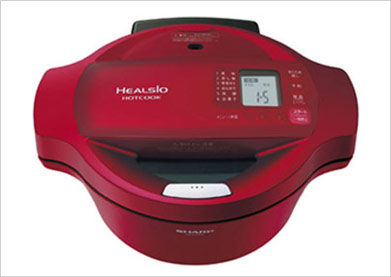
- *1
- For home-use electric cookers in the Japanese market. As of November 5, 2015; based on Sharp research.
- *2
- 16 menu items
- *3
- Can be set up to 12 hours in advance.
2016

2016
Mosquito-Catching Plasmacluster Air Purifier
Sharp released the FU-GK50, a Plasmacluster air purifier that can catch mosquitos. A world-first*1, the FU-GK50 makes use of its suction force and mosquitos’ behavior to catch those annoying insects with a sticky sheet instead of chemicals.
The FU-GK50 creates an environment attractive to mosquitos: it emits 360-nm UV light, and the main unit is black and has small openings that the bugs can enter. The approaching mosquitos are sucked in by the flow of air during air purification and get stuck on the sticky sheet.
Because it uses no chemicals, the FU-GK50 has been lauded for bringing peace of mind to households with infants, the elderly, and pets.
The FU-GK50 also offers advanced air purification. Its Speedy Circulating Airflow draws in faraway dust and its three filters (including an Electrostatic HEPA Filter*2) effectively collect dust and deodorize.
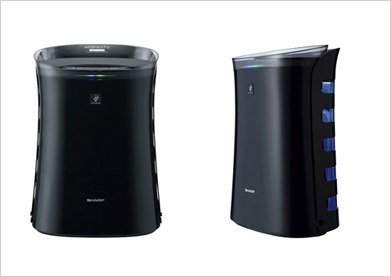
- *1
- The world’s first air purifier to have a mosquito-catching function using UV light, a black mosquito-attracting panel, and a sticky mosquito-catching sheet. This function was first available in September 2015 on models for the ASEAN market, and was made available in Japan on April 23, 2016.
- *2
- This filter can collect at least 99.97% of minute 0.3-µm airborne particles. Note that this is the percentage of dust removed from the air that passes through the filter, not the percentage removed from the entire room.
- *
- Plasmacluster and the Plasmacluster logo are registered trademarks of Sharp Corporation.
2016
RoBoHoN Mobile Robotic Phone
RoBoHoN is a world-first*1—a small, easily portable robot-shaped phone.
It was developed in collaboration with Tomotaka Takahashi, Project Associate Professor at the University of Tokyo’s Research Center for Advanced Science and Technology and CEO of robot development company Robo Garage Co., Ltd. This humanoid robot can walk on two legs and is compact enough (approx. 19.5 cm tall) to be carried almost anywhere.
RoBoHoN has all the basic mobile phone functions—phone, e-mail, camera—as well as a built-in projector*2 for projecting photos or videos onto a screen or wall. Users can also download dedicated apps to give RoBoHoN new functions.
Not only can RoBoHoN communicate through dialogue and gestures, but it can also make body movements like standing up, walking, and dancing. Such features have made RoBoHoN a hit—a “partner” that you can feel attached to.
RoBoHoN has garnered some high-profile attention, such as through its exhibit at the G7 Ise-Shima Summit in 2016. It’s also seeing increasingly widespread use; for example, commercial applications such as providing multilingual services for tourists.
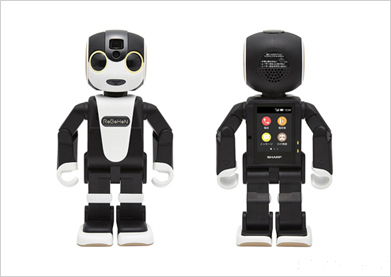
- *1
- For mobile phones, as of April 14, 2016 (based on Sharp research).
- *2
- RoBoHoN’s projector function can only be used by the registered user of that particular RoBoHoN.
- ●
- RoBoHoN and the RoBoHoN logo are registered trademarks of Sharp Corporation.
2016
Ultrasonic Washer
Sharp released the UW-A1 ultrasonic washer, which quickly and effectively removes stains*1 on clothes and other fabric products. Using ultrasonic vibrations of 38,000 times per second, the UW-A1 gets rid of stains that are otherwise hard to remove by hand or with a washing machine.
Ultrasonic vibrations of 38,000 times per second generate vacuum bubbles between the water-soaked fibers. When these bubbles burst, they generate a powerful force that flicks away the dirt. The UW-A1 can easily remove grime from collars and sleeves, cosmetics such as foundation and lipstick, and food stains. Because the UW-AI cleans with the power of bursting bubbles, it is gentle and thus minimizes damage to fabrics*2.
The UW-AI is cordless, rechargeable, compact, and weighs only 200 grams*3. This means you can take it outside the laundry room and use it to remove stains on the go.
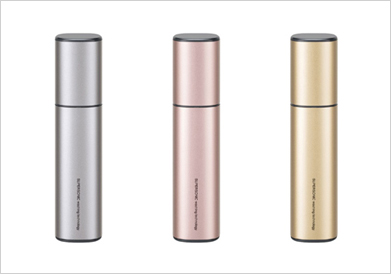
- *1
- The cleaning effectiveness may differ depending on the clothing material, the type of stain and detergent, and whether or not detergent is used. The UW-A1 cannot remove dyes, chemically altered stains (old yellowish stains, discolorations, etc.), and stains affixed by adhesive or organic solvent (paint, permanent markers, India ink, hair dyes, manicure, inks, colorants, etc.).
- *2
- The results may differ depending on the material, thickness, weave, and stitch of the clothes.
- *3
- Not including the cap.
2016
Healsio Griller Superheated Steam Oven
Sharp released the AX-H1 Healsio Griller superheated steam oven, which uses the same superheated steam as Sharp’s other Healsio ovens for healthy, delicious cooking. The compact AX-H1 is exclusively for superheated steam cooking and can quickly make fried or roasted dishes, or reheat them*1.
For breakfast, the AX-H1 toasts bread to delicious perfection. You can also prepare a breakfast special—toast, bacon, and sunny-side-up eggs—using the oven’s ability to cook different ingredients at the same time.
For dinner, heating frozen foods or reheating ready-to-eat dishes restores their just-cooked deliciousness by reducing excessive oil. The AX-H1 can also make “fried” foods without actually using frying oil, as well as grilled seasonal vegetables that allow you to savor the flavors of the season.
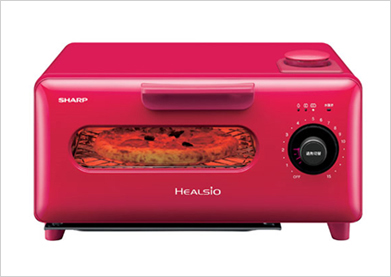
- *1
- Of the cooking functions on Healsio ovens, the AX-H1 can roast and fry, but it cannot steam or boil.
- *
- Healsio, the Healsio logo, Healsio Griller, and the Healsio Griller logo are trademarks of Sharp Corporation.
2017

2017
AGEs Sensor
Simply insert your finger to have the RQ-AG01J measure your body’s accumulation of AGEs (advanced glycation end-products). AGEs contribute to aging*1.
No blood samples are required. Simply put the tip of your middle finger into the device, and after 30 to 60 seconds, the RQ-AG01J will measure the amount of accumulated AGEs. Certain types of AGEs have autofluorescence (the natural emission of light after having absorbed light). Taking advantage of this characteristic, the RQ-AG01J applies near-UV light to the finger and calculates the accumulation level of AGEs by measuring and analyzing the amount of light emitted by the AGEs in the finger’s veins.
The results are displayed on a five-point scale from A to E. It also shows the user’s rank (1st to 100th place) when compared to people of the same age group*2. The included printer can be used to print out the results.
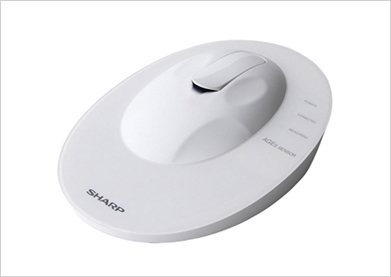
- *1
- Glycation (the bonding of sugar to protein) is one of numerous factors that contribute to aging.
- *2
- Based on data of several hundred people gathered through Sharp’s own clinical research, the RQ-AG01J places 100 people in each age group and indicates the rank of the user (1st to 100th place) in that age group.
- *
- Note: AGEs are the result of the bonding of sugar to protein. AGEs can be generated inside the body, when a person takes in sugar through food or drink, and that sugar bonds with protein, which is a major component of the human body. When there is excess sugar inside the body due to unhealthy lifestyle habits such as a poor diet and lack of exercise, AGEs are generated at an accelerated pace and accumulate in veins, bones, skin, and other bodily organs. AGEs are believed to be a factor in aging and are rapidly becoming a new index in gauging people’s health.
2017
RACTIVE Air Cordless Canister Vacuum Cleaner
Sharp released RACTIVE Air, a cordless canister vacuum cleaner weighing a total of 2.9 kg, the world’s lightest*1 for a cleaner with a motorized power brush. Sharp made this possible by making the main unit lighter and using lightweight material for the wand.
The wand is made of dry carbon (a type of CFRP), a strong, lightweight material that is also used in aircraft. By significantly reducing the strain on the hand, it is easier to clean thresholds, steps, and narrow spaces. Stairways are particularly hard to clean, but with RACTIVE Air, the strain placed on the arm is reduced by up to 20%*2 compared to Sharp’s previous model (cordless stick vacuum cleaner). And thanks to a smaller and lighter main unit motor and electronic circuits, the main unit’s weight*3 is just 1.8 kg. The cleaner is easily portable over thresholds, steps, and stairways.
A powerful turbo fan, high-efficiency lithium-ion battery, and compact motorized power head give this cleaner the same suction power as on corded canister vacuum cleaners*4.
The RACTIVE Air lineup includes a bagged type for easy dust removal and a bagless cyclonic type that maintains suction power even when the canister is filled with dirt.
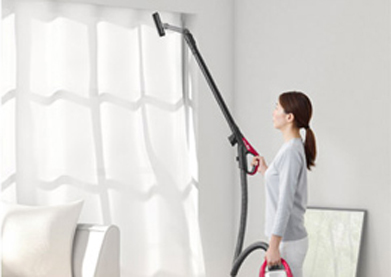
- *1
- Total weight of a household canister vacuum cleaner with a power brush (including main unit, battery, hose, wand, and suction head). As of August 2, 2017 (based on Sharp research). Released September 14, 2017 in Japan.
- *2
- According to tests by the Hyogo Prefectural Institute of Technology. Based on Sharp standards, the strain put on the muscles of the right arm was compared when cleaning a stairway with the EC-AS500 (RACTIVE Air) and with the EC-A1R (cordless stick cleaner released in 2016). This figure may vary depending on usage conditions and environment.
- *3
- Weight of the main unit and battery.
- *4
- Comparing dust suction performance of the EC-P8X corded cyclonic cleaner and the EC-AS500. Tests were based on Sharp standards complying with the JIS C 9108 standard for electric vacuum cleaners and compared dust suction on a carpet. Performance may vary depending on floor material and usage conditions.
2017
LC-70X500 AQUOS 8K 70-Inch 8K-Compatible LCD TV
Equipped with a high-definition, high-image-quality LCD panel, the LC-70X500 is one of the AQUOS 8K Series of 8K-compatible TVs.
The TV aims for the ultimate in realistic images—even greater than those expressed in 4K resolution. With a resolution 16 times that of full HD, the 8K LCD panel reproduces images with ultra-fine detail beyond that visible to the naked eye. Add technologies for wide color gamut and high brightness that Sharp has nurtured over the years in its AQUOS TVs, and viewers can experience images like never before.
The LC-70X500 can upconvert existing full-HD or 4K images from digital broadcasts (terrestrial and BS/110° CS satellite) into 8K images. Rich Color Technology Pro (wide-color-gamut technology) and MEGA Contrast* (dynamic range expansion technology for reproducing image brilliance) also enable viewers to watch current TV content in even higher quality.
Connecting the optionally available 8K broadcast receiver lets you watch 8K broadcasts, which started in Japan on December 1, 2018, in outstanding 8K quality.
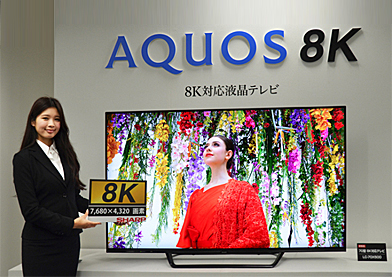
- *
- MEGA: Master Engine Gain Analyzer
2017
8C-B60A 8K Professional Camcorder
Sharp released the 8C-B60A professional-use 8K camcorder, the world’s first*1 camcorder integrating capabilities*2 for shooting, recording, playback, and line output of 8K (60p*3) video. This all-in-one camera/recorder unit was developed with technical cooperation from Astrodesign, Inc.
Besides the ability to shoot images in high-resolution 8K (60p), this camcorder is designed to offer ease of use in shooting and recording and to lessen the burden on the camera operator in the post-recording editing process. The 8C-B60A’s image pickup device is a large, Super 35-mm-equivalent CMOS image sensor with 33 million pixels. Compression utilizes a coding method*4 that exerts minimal burden on the CPU, thus enabling efficient 8K (60p)-image editing and approximately 40 minutes of continuous recording (when using the bundled 2TB SSD pack).
Because it allows real-time output of 8K (60p) uncompressed images at the same time that recording is taking place, the 8C-B60A can be used for live transmissions as well.
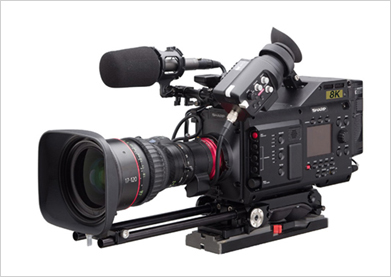
- *1
- As of November 7, 2017 (based on Sharp research).
- *2
- The 8C-B60A requires a commercially available lens, viewfinder, microphone, and other equipment.
- *3
- Displays 60 frames per second (progressive).
- *4
- Grass Valley HQX Codec
2017
funband Wearable Device
funband is a wristwatch-type wearable device for fans of Japanese professional baseball. In addition to live scores, it delivers*1 the latest news on your favorite team and players.
funband uses Bluetooth® to connect to the cloud via a smartphone. The display shows live game scores and at-bat performance (such as home runs or hits). And it notifies you of incoming news by vibration and LED lamps.
funband delivers news on the team and its players, as well as other timely topics, every day. So you can root for your team during the regular season and even the off-season.
It also has functions that make watching games more exciting. Its built-in sensor detects and counts your arm movements to show how enthusiastically you’ve been cheering on your team. The results are accumulated on the cloud. funband’s display shows the amount of “cheering power”, which you can also check on your smartphone. Wherever you are watching—at the ball park or elsewhere—you can share with other fans the excitement of rooting for your favorite team.
In 2017, Sharp released models for each team of the two Japanese professional baseball leagues. Not only does funband bring new excitement to baseball, but it can also be used as a regular wristwatch.
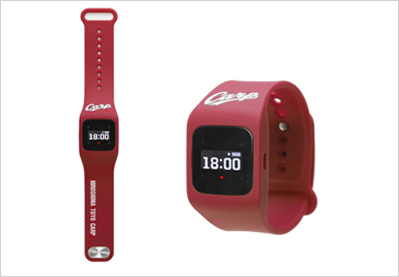
- *1
- The user needs to install a dedicated smartphone app and subscribe to a fee-based service. The service is free of charge for the first year of subscription (first-time users only). Also, the user needs to apply for membership in Sharp’s Cocoro Members service.
- *
- funband is a trademark of Sharp Corporation.
- *
- Bluetooth is a registered trademark of Bluetooth SIG, Inc.
2018

2018
AQUOS R2 Smartphone
Sharp released the AQUOS R2, the world’s first smartphone*1 to have two cameras—one for shooting videos and the other for taking photos—on the back*2. This unique configuration allows you to take videos and photos at the same time. The R2 was sold via carriers NTT Docomo, SoftBank, and KDDI in Japan.
The R2’s video camera (called Dramatic Wide Camera) has an ultra-wide-angle lens boasting a 135-degree*3 field of view, while the photo camera has 22.6 megapixels. By optimizing image stabilization and focus for each camera, the R2 can take exciting in-focus video (even when the object moves) and clear, vivid photos—simultaneously.
While shooting video, the R2’s artificial intelligence analyzes the object and the shot composition. It can automatically take photos of memorable scenes—such as the moment a baby smiles or a pet looks into the camera—while shooting video. The R2 lets users experience a new way of taking images—shooting immersive videos and high-resolution photos with a single unit.
What’s more, the R2 has a large, 6.0-inch WQHD+ (3040 x 1440 pixels) high-speed IGZO LCD*4. It also features—for the first time in a smartphone*5—Dolby VisionTMand Dolby Atmos®, letting you enjoy powerful sound along with super-realistic images.
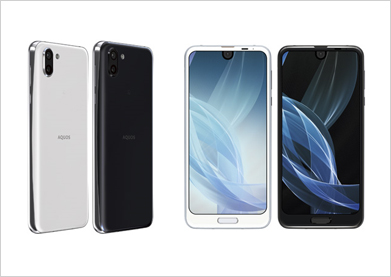
- *1
- As of May 8, 2018, based on Sharp research. For a smartphone with two rear cameras that can take photos with the still-image camera while shooting video with the video camera.
- *2
- In addition to two rear cameras, the R2 has a front-facing camera.
- *3
- Focal length 19 mm (35 mm equivalent focal length on a film camera). Image stabilization will narrow the field of view.
- *4
- The IGZO LCD was developed jointly for mass production by Sharp and Semiconductor Energy Laboratory Co., Ltd.
- *5
- As of May 8, 2018, based on Sharp research.
2018
Pet Care Monitor Cat Litter Tray
Sharp developed the HN-PC001 Pet Care Monitor, a cat litter tray that automatically measures the pet’s urine volume and frequency, the pet’s weight, and other factors, and records and analyzes them on the cloud*1*2. These reports are then sent to the owner’s smartphone*3 so that they can keep track of their pet’s health. The launch of this product marked Sharp’s entry into the pet business.
The measurement data saved to the cloud is analyzed via Sharp’s own abnormality detection algorithm (AI)*4. If any abnormalities are detected, such as too much or too little urine, too much time spent in the litter tray, and so forth, the HN-PC001 will send a notice to the owner’s smartphone.
Cats tend to refrain from using the litter tray if its immediate surroundings are too chilly. The HN-PC001 can solve this problem by measuring the temperature around the litter tray, thus helping to maintain a comfortable environment.
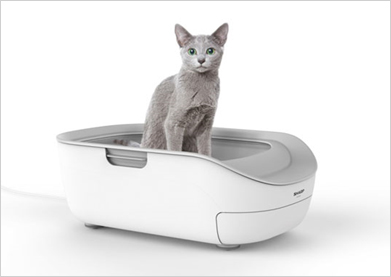
- *1
- The Pet Care Monitor is not for diagnosing illness. Although it will notify pet owners of any abnormalities found via the collected data, it does not guarantee accuracy.
- *2
- The Pet Care Monitor and its services require access to a wireless LAN (or a smartphone) and a subscription to the fee-based Cocoro Pet service.
- *3
- The user needs to install the Cocoro Pet dedicated app.
- *4
- Jointly developed with Professor Yoshiharu Okamoto of the Joint Department of Veterinary Medicine, Faculty of Agriculture, Tottori University.
- *
- AIoT is a word coined by Sharp, combining the words AI (artificial intelligence) and IoT (Internet of things). AIoT is a vision of how all kinds of products will connect to artificial intelligence via the cloud and become a people-oriented existence. AIoT is a registered trademark of Sharp Corporation.
2018
AQUOS Products for New 4K Satellite Broadcasts
4S-C00AS1 4K Tuner/
AQUOS 4K Recorder/
AQUOS 4K AIoT-Ready LCD TV
Sharp released the 4S-C00AS1 4K tuner and AQUOS 4K recorder, which enable viewing*1 and recording of new 4K satellite broadcasts*2, and the AQUOS 4K AIoT-ready LCD TV. These products were launched in the run-up to the start of new broadcasts, which began on December 1, 2018 in Japan.
The 4S-C00AS1 is equipped with BS 4K/110° CS 4K tuners. Simply connecting it to a 4K-compatible TV*3 via an HDMI cable enables you to easily watch new 4K satellite broadcasts in stunning 4K resolution. You can also record these broadcasts in 4K quality onto an optionally available external hard drive.
The 4S-C00AS1 supports the new HDR (high dynamic range) standard, called HLG (hybrid log gamma), adopted for the new 4K broadcasts. If your TV supports the previous HDR standard*4, called HDR10, the 4S-C00AS1 will convert HLG images to HDR10 images, so that you can still enjoy high dynamic range.
The 4B-C40AT3/C20AT3 AQUOS 4K recorders (equipped with BS 4K/110° CS 4K tuners) connect to a 4K-compatible TV*3 for watching new 4K satellite broadcasts. The built-in hard drive records 4K-resolution images as is, and these 4K recordings can be dubbed onto Blu-ray discs.
It also allows playback of Ultra HD Blu-ray discs*5. This new format supports high-resolution 4K, high-brightness HDR, and wide-color-gamut BT.2020 standards.
The 4T-C60AN1/C50AN1/C45AL1 AQUOS 4K AIoT-ready LCD TVs have two built-in BS 4K/110° CS 4K tuners. This means you can watch a program on a new 4K channel while recording a program on another 4K channel to an optionally available external hard drive.
These TVs incorporate AQUOS 4K Smart Engine PRO, a technology for reproducing the quality of new 4K broadcasts. This makes you feel you’re right in the middle of the action. The TVs also support Sharp’s Cocoro Calendar service, which displays news on community events and also lets you enter family members’ schedules via voice into the onscreen calendar.
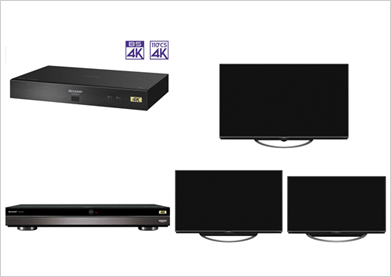
- *1
- To watch new 4K satellite broadcasts requires replacing existing equipment with an antenna supporting right-/left-handed circularly polarized waves, a mixer, a booster, a splitter, and other necessary equipment having the “SH” mark, as well as a wideband cable and the necessary electrical engineering work.
- *2
- “New 4K satellite broadcasts” refer to 4K BS/110° CS broadcasts. The 4S-C00AS1 does not support the viewing and recording of 8K broadcasts.
- *3
- To watch 4K requires the 4K recorder and a 4K-compatible TV (supporting HDCP 2.2).
- *4
- For TVs that do not support HDR (both HLG and HDR10), images are output in the SDR (standard dynamic range) format.
- *5
- Due to copyright matters, certain Ultra HD Blu-ray discs may not be able to play back unless the 4K recorder is connected to the Internet. To watch these discs in HDR requires connecting the 4K recorder to an HDMI jack on a TV that supports the HDR signals of Ultra HD Blu-ray.
- *
- AIoT is a word coined by Sharp, combining the words AI (artificial intelligence) and IoT (Internet of things). AIoT is a vision of how all kinds of products will connect to artificial intelligence via the cloud and become a people-oriented existence. AIoT is a registered trademark of Sharp Corporation.
- *
- Using the Cocoro Vision cloud service and Google Assistant requires an Internet connection.
2018
Products Compatible with AIoT Cloud Services
Megafreezer Series Plasmacluster Refrigerators/
X Series Wireless LAN Plasmacluster Air Conditioners
Sharp released a succession of industry-first, people-oriented products compatible with AIoT cloud services.
The SJ-GX55E/GX50E Megafreezer Series Plasmacluster refrigerators are compatible with Sharp’s Cocoro Kitchen AIoT cloud service and are the first such products in the industry*1 to link to cooking appliances such as Sharp’s Healsio Water Oven and Healsio Hot Cook electric waterless cooker. The refrigerators’ menu navigation function provides users with ideas for easy-to-make dishes that can be prepared with the linked appliances and even helps make these dishes. The refrigerators come with a function for communication among family members: users can send messages from outside locations to the refrigerator via their smartphone, for example telling their children what snacks are in the refrigerator and confirming when children have come home based on whether messages have been read.
The wireless LAN-compatible X Series Plasmacluster air conditioners use the improved Cocoro Air AIoT cloud service. In an industry first*2, cloud-based AI uses information such as room temperature changes and air conditioner usage history. It analyzes and learns these factors—which include daily lifestyle patterns and a room’s tendency to cool down or heat up—so that it can provide optimal energy efficiency geared to the needs of each home.
The air conditioners provide maximum comfort at minimal electricity usage. They achieve this, for example, by matching their operation to when users arrive home so as to provide cooling at low electricity consumption. They also automatically adjust operation when no one is at home. These air conditioners are smarter and more convenient than ever. For example, an advice function gives tips on saving electricity, and a safeguard function alerts an app on the user’s smartphone when, for example, room temperature exceeds user parameters or when a person is detected in the room.
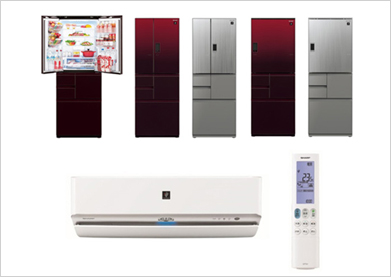
- *1
- For CFC-free residential refrigerators/freezers in Japan, as of August 6, 2018 (based on Sharp research). Released August 23, 2018.
- *2
- For residential air conditioners (based on Sharp research). Technology for analyzing and learning room performance and lifestyle patterns via the cloud. Released October 25, 2018.
- *
- AIoT is a word coined by Sharp, combining the words AI (artificial intelligence) and IoT (Internet of things). AIoT is a vision of how all kinds of products will connect to artificial intelligence via the cloud and become a people-oriented existence. AIoT is a registered trademark of Sharp Corporation.
- *
- Using Cocoro Kitchen and some of the voice-activated functions requires a wireless LAN connection and a push-button-type wireless LAN access point device.
- *
- Plasmacluster and the Plasmacluster logo are registered trademarks of Sharp Corporation.
2018
AQUOS Products for 8K Satellite Broadcasts
8S-C00AW1 8K Tuner/
8R-C80A1 8K-Compatible USB Hard Drive/
AX1 Series AQUOS 8K LCD TV with Built-in 8K Tuner
Sharp developed the 8S-C00AW1 8K tuner*1, 8R-C80A1 8K-compatible USB hard drive, and AX1 Series AQUOS 8K LCD TV with built-in 8K tuner, products that are compatible with the 8K and 4K satellite broadcasts that began in Japan on December 1, 2018. These products were released simultaneously and prior to the start of the broadcasts so that users could immediately enjoy the high-definition 8K images.
The 8S-C00AW1 8K tuner has two BS 8K/BS 4K/110° CS 4K tuners and 8K video output jacks comprising four HDMI jacks, and is the world’s first*2 such product that can receive the new 4K8K satellite broadcasts. Connecting this tuner to the LC-70X500*3 AQUOS 8K 8K-compatible LCD TV, which was released in 2017, gives users ultra-high-definition images of approximately 33 million pixels, a resolution 16 times greater than full HD.
The 8R-C80A1 8K-compatible USB hard drive is compatible with the new 4K8K satellite broadcasts. Using it together with the AQUOS 8K LCD TV*4 that was simultaneously released allows users to record*5 8K and 4K TV programs from the new broadcasts as is. The 8K broadcasts can be recorded in their original quality—a high resolution giving approximately 33 million pixels. Thanks to the huge 8 TB capacity of the hard drive and its ability to partition data recorded onto it, users get high-speed writing and reading of vast amounts of image data.
The AX1 Series AQUOS 8K LCD TV with built-in 8K tuner gives 16 times the resolution of full HD (2K) for viewing of 8K broadcasts that provide on-screen realism like never before, a world first*6. The display section comprises the new 8K Double-Speed LCD, which displays 8K images in high brightness and wide color gamut, and at a refresh rate of 120 Hz, double the previous. This means gorgeous, smooth display of 8K images. The image processing engine is the newly developed AQUOS 8K Smart Engine PRO, which can carry out high-speed processing of vast amounts of data: 32 times*7 the amount of full-HD images.
Not only can it give smooth display of 8K at double the refresh rate, but it can also make use of this high-speed processing for upconverting, thus converting terrestrial digital broadcasts into high-definition 8K images.
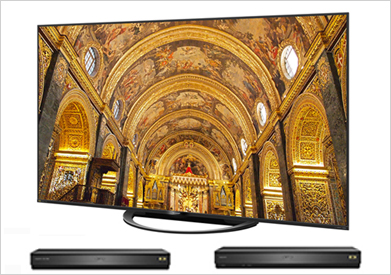
Bottom left: 8R-C80A1 8K-compatible USB hard drive
Bottom right: 8S-C00AW1 8K tuner
- *1
- The 8K tuner can receive 4K and 8K broadcasts (the new 4K8K satellite broadcasts in Japan) via BS and 110° CS. To watch 4K and 8K broadcasts requires replacing existing equipment with an antenna supporting right-/left-handed circularly polarized waves, a splitter, a branching filter, a booster, cables, and other equipment.
- *2
- As of October 15, 2018. For tuners with a function for receiving 8K broadcasts on BS, which commenced in December 2018 in Japan.
- *3
- Does not have a tuner for receiving the new 4K8K satellite broadcasts. Has a 7680 x 4320-pixel LCD panel.
- *4
- AQUOS 8K models: 8T-C80AX1/C70AX1/C60AX1. Can also be used with the 8S-C00AW1 8K tuner.
- *5
- The 8R-C80A1 does not have a tuner for the new 4K8K satellite broadcasts.
- *6
- As of October 15, 2018. For TVs equipped with a function for receiving 8K broadcasts on BS, which commenced in December 2018 in Japan.
- *7
- Compared to full HD (1920 x 1080 pixels, 60 Hz refresh rate), 16 times the resolution and double the refresh rate.
2018
AQUOS zero Smartphone with OLED Display
Sharp created the AQUOS zero smartphone, at just 146 grams—the world’s lightest in its class*1. Sharp’s first smartphone to feature on OLED display, the AQUOS zero was made for SoftBank Corp.
The 6.2-inch, WQHD+ (2992 x 1440 pixels) screen is the largest ever on an AQUOS phone and uses an OLED display manufactured by Sharp in Japan. It boasts a high contrast of 1,000,000:1 and a 100% DCI-P3 color gamut (a standard of color gamut for digital cinema projection). Thanks to a high-image-quality technology called Rich Color Technology Mobile, the AQUOS zero gives smooth gradation and rich color tone for realistic, vivid colors.
In addition to the OLED display requiring no backlight, the AQUOS zero adopts a magnesium alloy on the sides and light, high-strength Technora® aramid fiber*2 on the back to achieve a weight of just 146 grams, the world’s lightest for a smartphone with a 6-inch or larger screen and a battery size 3,000 mAh or above.
The AQUOS zero has a gently rounded convex screen that lets users enjoy smooth, natural touch operation. In addition, it features a high-performance Qualcomm® SnapdragonTM 845 CPU and large 6 GB RAM and 128 GB ROM, giving it high-speed processing so users can enjoy hours of video games and movies.
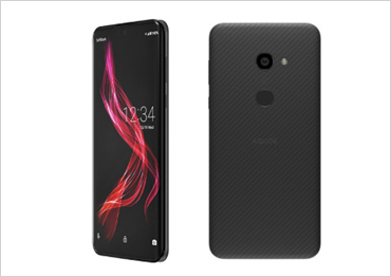
- *1
- For smartphones with a 6-inch or larger screen size, a battery size 3,000 mAh (nominal) or above, and waterproofing (IPX5 or above). Released in December 2018. Based on Sharp research.
- *2
- Synthetic fiber with high strength, high elasticity, high heat resistance, and high chemical resistance.
2019

2019
RoBoHoN Mobile Robotic Phone
Sharp created a stir in 2016 when it released RoBoHoN, the world’s first portable robot-shaped phone. In 2019, it expanded the lineup with the SR-03M-Y (LTE/3G model) and the SR-04M-Y (Wi-Fi model), which are capable of walking, and the sitting SR-05M-Y RoBoHoN Lite (Wi-Fi model).
A security application allows RoBoHoN to watch the home while the user is out, detecting and photographing people entering the house and then emailing the photos to the user. This comes in handy for parents who want to know if their children have come home from school. The eRemote Mini IoT remote controller (sold separately) allows the RoBoHoN to respond to voice commands to, for example, operate things like TV and lighting.
Corporate users get functions like facilities guide and guest welcoming. By sensing when people approach, RoBoHoN can, for example, explain items in a store, showroom, or museum, and welcome guests at a company reception desk. And it can speak Japanese, English, Chinese, and Korean.
Also new to the lineup is the SR-05ME-Y RoBoHoN Lite HEMS (Wi-Fi model), which takes voice commands to do things like check the power generation capacity of solar power systems and operate appliances.
The expanded RoBoHoN lineup allows the product to be used beyond the home to include corporate customers like hotels and English language schools.
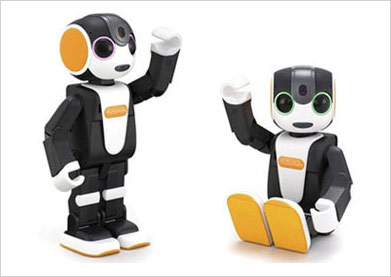
2019
AN-SX7A AQUOS Sound Partner Wearable Neck Speakers
Sharp released the AN-SX7A AQUOS Sound Partner wearable neck speakers. The built-in proprietary Acoustic Vibration System gives powerful bass tones and achieves balanced playback of everything from the low to medium/high ranges. By adding vibration to the bass, Sound Partner makes users feel like they are in the middle of the music.
The speakers include three sound modes—standard, dynamic, and voice—so users can match sound to the music genre and source. They are compatible with Qualcomm aptX Low Latency*, which ensures that Bluetooth devices can deliver sound in sync with visual media such as TV.
Sound Partner wearable neck speakers are ergonomically designed for relaxing listening, so users get hours of fatigue-free entertainment.
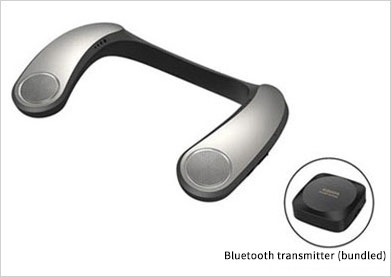
- *
- When using with the bundled Bluetooth transmitter.
2019
EC-SR3SX-P/-S and EC-SR3S-P RACTIVE Air Power Cordless Stick Vacuum Cleaners
The RACTIVE Air Power cyclonic cordless vacuum cleaners have the power and charge-life to thoroughly clean an entire home. The cordless, stick form marks a new product category that eases vacuuming for users.
These vacuum cleaners have a large-capacity, high-voltage 25.2 V rechargeable lithium-ion battery and a high-blowing, high-pressure 3D fan motor, along with an optimal construction and air intake/exhaust path, which combine to give greater suction power than previous Sharp products. When using the full-power mode to clean hard-to-remove dirt in just five seconds, it is 1.5 times*1 more powerful than previous models, the highest ever for Sharp cordless stick-type products.
The removable large-capacity, high-voltage battery runs for 60 minutes*2 on one charge and charges fully in just 80 minutes*3. The EC-SR3SX premium model comes with two batteries, which can be switched so that users get up to 120 minutes*4 of operation on low-power mode, two times that of Sharp’s previous models (which gave maximum 60 minutes on auto mode and 24 minutes on high-power mode).
The vacuum cleaners’ wand is made of aluminum and has an oval cross section, making it just one-quarter the thickness*5 and significantly lighter than Sharp’s previous models using a plastic wand. The strong yet light body has a standard weight of just 1.9 kg.
Now with a stronger free-running assist function, the new models lessen the burden on the user by approximately 30%*6 compared to Sharp’s previous standard-weight 1.5-kg models.
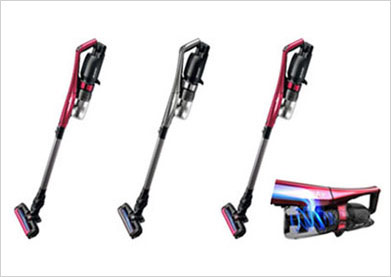
- *1
- Comparative vacuum pressure in full-power mode in a Sharp-conducted experiment of suction performance against the Sharp EC-AR2SX/AR2S and EC-SR3SX/SR3S (2018 models). (EC-AR2SX/AR2S: approx. 8.5 kPa; EC-SR3SX/SR3S: approx. 13.4 kPa.) Performance will differ depending on usage conditions and environment.
- *2
- The operation time using one battery and a bundled suction head attachment (removable brush), in low-power mode, under prescribed Sharp conditions, and using a new, fully charged battery. Performance will differ depending on floor type, usage environment, and usage conditions.
- *3
- Time to charge one battery. Charging time will differ depending on ambient temperature, usage conditions, and other factors.
- *4
- The maximum operation time using two batteries and a bundled suction head attachment (removable brush), under prescribed Sharp conditions, and using a new, fully charged battery. Performance will differ depending on floor type, usage environment, and usage conditions. Maximum operation time for Sharp EC-AR2SX (2018 model) is 60 minutes.
- *5
- Compared to main unit wand of Sharp EC-SX530 (2016 model). EC-SX530’s wand thickness is approx. 2 mm, and EC-SR3SX/SR3S’s wand thickness is approx. 0.5 mm.
- *6
- Measured by HAL Design Laboratory at an experiment conducted in May 2019. Participants: 13 women ages 30 to 60s. Comparison of users’ muscle activity at six locations (arms, hips, legs, etc.) when vacuuming wooden and carpet floors with the EC-SR3SX and the EC-AR2SX (2018 model) under prescribed Sharp conditions. Performance will differ depending on usage conditions and environment.
2019
Lessbea® Beacon Powered by Dye-sensitized Solar Cell
Sharp’s Lessbea® beacon is powered by a dye-sensitized solar cell that has been certified*1 as having the world’s highest power generation efficiency under the outdoor evaluation standard (AM1.5) in the field of dye-sensitized solar cells. It can therefore give off stable signals at an interval of one per second even in dark spaces of about 50 lx*2, such as under indoor emergency lighting. This gives it top-class performance*3 among solar-powered beacons.
Most conventional beacons use primary batteries as a power source, and must be installed in a high place, at least two meters above ground, to avoid radio wave attenuation. This means significant maintenance costs due to periodic battery changes and the extra work necessitated by their high location. Sharp’s Lessbea® solves both these problems. Providing both high performance and a compact size measuring just 74 mm (W) x 7 mm (H) (at its thickest) x 134 mm (D), the Lessbea® boasts a subtle design and no visible screws, thus making it a good match for installation in office environments.
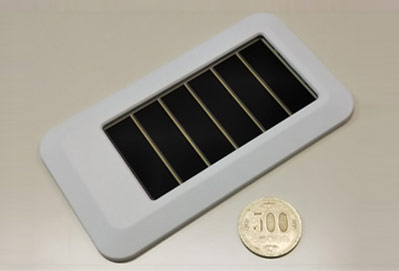
- *1
- In 2012, Sharp’s dye-sensitized solar cells were certified as having the world’s highest power generation efficiency among all dye-sensitized solar cells by the trade journal Progress in Photovoltaics, which documented power generation efficiency (under the outdoor evaluation standard AM1.5) of various solar cells. Sharp has maintained this honor. This was achieved under a project subcontracted by Japan’s New Energy and Industrial Technology Development Organization (NEDO).
- *2
- Based on the Japanese Industrial Standards’JIS Z9110 lighting standard.
- *3
- Based on Sharp research.
2019
TEKION COOLER bag
Sharp’s TEKION COOLER bag uses Sharp’s unique and advanced cold-retention material to keep drinks at a cool, refreshing temperature of –2°C. The bag uses chloroprene rubber, a light, easy-to-fold material used for wetsuits. Even subzero drinks put inside won’t cause condensation, so users can take it anywhere and place it on a table, without worry of water droplets forming on the surface.
TThe bag’s cold-retention material comes from Sharp’s years of research in LCD materials. It can be designed to melt*1 at a specific temperature in the –24°C to +28°C range*2. Users can enjoy all kinds of food and drink in the most satisfying temperature range for consumption.
To bring this cold-retention material to market, in March 2017 Sharp formed an in-house venture business called TEKION LAB. Tekion means “ideal temperature” in Japanese. Through the Makuake crowd-funding service, Sharp tied up with a sake brewery and conducted marketing stressing this new way to enjoy subzero alcoholic beverages. The TEKION COOLER bag marked the full-scale launch of TEKION products under the Sharp brand. Sharp is teaming up with companies in other industries to expand TEKION products using cold-retention material into the fields of sports, beauty, medicine, and logistics, among others.
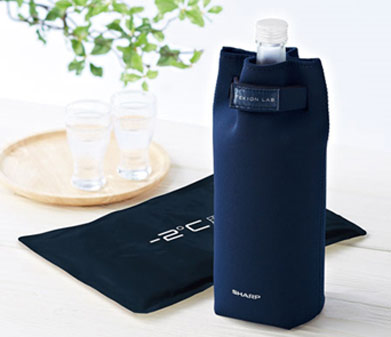
- *1
- The cold-retention material melts at a specific temperature, transforming from a solid to a liquid. At that time, it absorbs the surrounding heat and maintains not only its own temperature but also that of the ambient air and of whatever it comes in contact with at a certain temperature. The maintained temperature and length of time will differ depending on how much cold-retention material is used and on usage conditions.
- *2
- Includes the temperature range of cold-retention material currently under development.
2019
30-inch 4K Flexible OLED Display
Sharp and Japan Broadcasting Corporation (NHK) co-developed a 30-inch 4K flexible organic LED (OLED) display.
The OLED display, with light-emitting elements formed onto each of the RGB subpixels (RGB light emission method) of a 30-inch-diagonal (approximately 76 cm) flexible film substrate, is the largest display of its kind in the world*1.
The light-emitting elements are formed with ultra-high precision onto each of the RGB subpixels using the vapor deposition method. This renders a color filter unnecessary and gives high light-use efficiency. The use of a film substrate means the display part of the panel is approximately 0.5-mm thick, and this allows the display to be rolled into a cylinder approximately 2 cm in radius that fits neatly in a storage case.
The display employs IGZO*2 thin film transistors (TFTs) to drive the OLED elements. NHK’s proprietary signal-processing technologies and panel drive technology were used in order to improve brightness uniformity and the sharpness of moving objects.
The 30-inch 4K flexible OLED display has garnered attention at events like Inter BEE 2019 and CES 2020.
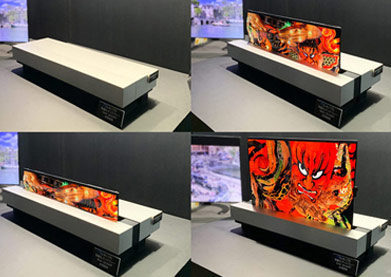
- *1
- For displays with light-emitting OLED elements formed onto red, green, and blue subpixels (RGB light emission method) on a film substrate and using no color filter. (As of November 8, 2019; based on Sharp research.)
- *2
- An oxide semiconductor comprising indium (In), gallium (Ga), zinc (Zn) and oxygen (O). It is used as a semiconductor material for TFTs that drive OLED and LCD displays.
2019
AY-L40/28/25/22P Airest Plasmacluster Air Conditioners
Sharp’s newest Plasmacluster air conditioner series, Airest, employs four continuous blowers that give it the strong air-dust-removal power of an air purifier. Its new construction has a dust-collecting and odor-removing filter at the air intake. These features have given the Airest the industry’s top air-purifying function*1 and made the series the only air conditioners to have met air cleaning standards stipulated by the Japanese air purifier industry.
The dust-collecting filter removes dust and bacteria, the causes of mold growth, and keep the air conditioner’s inside clean. In addition, the built-in Plasmacluster Next ion generator is effective against odors and mold that the filter cannot remove. The result is an ideal air environment for users.
The Airest products are controlled by cloud-based AI that makes use of weather forecasts in order to maintain maximum room comfort around the clock. Sharp’s proprietary*2 long-panel airflow control sends air evenly and comfortably throughout the entire room.
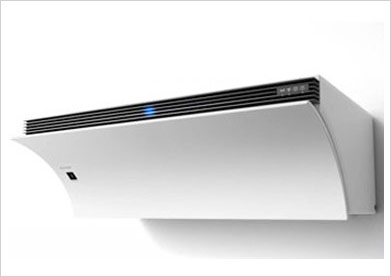
- *1
- For residential air conditioners for the Japanese market. Applicable floor space for air purifier operation of 91 m2, based on JEM Standards of the Japan Electrical Manufacturers’ Association. As of November 26, 2019; based on Sharp research.
- *2
- For residential air conditioners for the Japanese market. For models sending airflow in the direction of the ceiling. (Top and bottom opening-type; as of November 2019.)
- ●
- Plasmacluster and the Plasmacluster logo are registered trademarks of Sharp Corporation.
2020

2020
AQUOS R5G Smartphone
The AQUOS R5G smartphone is the first AQUOS smartphone compatible with the 5th-generation mobile communication system (5G) and also the first smartphone with an 8K wide camera. Making the most of 5G’s high speed and large capacity, the smartphone downloads large video data such as movies in just seconds, and quickly uploads videos taken with the built-in camera.
With the 8K wide camera, users can take life-like stills and videos at ultra-detailed 8K resolution (7,680 x 4,320) and with a wide field of view, great for large group shots where even individual faces are clear and recognizable. Proprietary Sharp AI enables the focus playback function, which automatically recognizes faces of people and pets (dogs, cats, etc.) in a video, and zooms in and plays them back.
The approximately 6.5-inch Pro IGZO LCD can display a billion colors, allowing for faithful reproduction ranging from skin texture to gradations of a blue sky, as well as making stills and videos easier to look at even under bright sunlight. It also combines high visibility and low power consumption. And with a high-performance CPU and high-speed, large-capacity memory, the R5G offers approximately 25% better CPU performance over Sharp’s previous model (AQUOS R3 released in fiscal 2019).
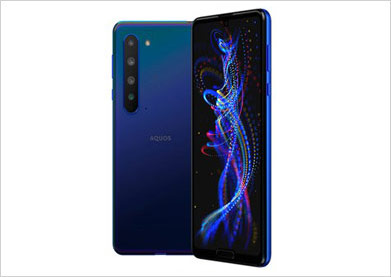
2020
MA-1050 Non-woven Mask
These masks are manufactured in the clean rooms at Sharp’s Mie Plant, where dust and other airborne particles are almost non-existent. The highly sanitary masks use a 99%* Cut Filter that prevents PM2.5 and pollen from getting in and virus droplets and particulates from getting in and out.
Consideration was also put into the shape of the mask, with a nose fitter that can match the line of the wearer’s nose, thus reducing the open space between the mask and the face and limiting the amount of virus droplets and particulates getting in. Wide, soft ear straps ensure minimal burden on the ears even when wearing the mask for extended periods.
In February 2020, when masks were in extremely short supply in Japan, Sharp answered a call for help from the Japanese government and began production in March 2020. Mask sales to the general public began on April 28 via a lottery system on Sharp’s COCORO STORE e-commerce website. The first round of the online sales lottery saw the numbers of people applying to purchase masks exceed Sharp’ planned sales volume.
In September 2020, Sharp added the MA-1050S, smaller masks for women and upper grade elementary school students. The company also gradually increased production capacity and in November cumulative production reached 100 million masks. Sharp has since then been coming up with new ways to bring high-quality made-in-Japan masks to more people. For example, in December 2020 Sharp launched its MA-R230 and MA-R230S periodic mask delivery service for shipping masks to customers at regular intervals.
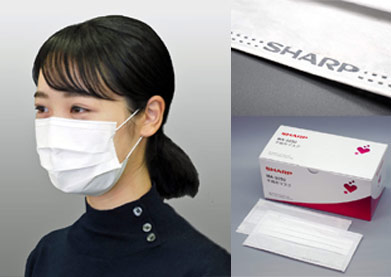
- *
- According to test results by Kaken Test Center.
Filtering efficiency: At least 99% for virus droplets (VFE test), at least 99% for bacteria droplets (BFE test), at least 99% for pollen, at least 99% for particulates (PFE test)
(VFE: Viral Filtration Efficiency, BFE: Bacterial Filtration Efficiency, PFE: Particle Filtration Efficiency)
2020
12°C Tekion Cold-retention Material
Using technology built up through research into LCD materials, Sharp developed 12°C Tekion cold-retention material for use in shipping fresh produce. Palsystem Consumers’ Co-operative Union, Tanix, and Sharp collaborated to build a new shipping system using Tekion cold-retention material, the first such product in the industry*1 made especially for fresh produce. Besides maintaining the quality of fresh produce shipped directly from producing regions, the system also dramatically reduces power consumption, solves labor shortage problems, and helps reform the way people work.
In conventional shipping, 0°C cold-retention material can cause low-temperature damage to the fresh produce, so buffer material must be placed between the produce and the cold-retention material to prevent quality deterioration. With 12°C Tekion cold-retention material, low-temperature damage is prevented and time and labor are saved since no buffer material needs to be inserted.
And by using 12°C Tekion cold-retention material, with its high melting point, users save about 40% annually on electricity needed to keep cold-retention materials at freezing. This is equivalent to the electricity consumption of about 950 average households*2, and converts to a reduction in CO2 emissions of about 2,000 metric tons. In addition, while fresh produce has traditionally been sorted at night, it can now start the morning of the day it arrives, thus helping solve the problem of labor shortages and leading to reformed work patterns.
Full-fledged application of 12°C Tekion cold-retention material to commercial business is not limited to shipping fresh produce. It is also being used as a product for end consumers. Descente Ltd. has released the Core Cooler*3, a glove employing Tekion cold-retention material to keep users cool during exercise on hot days.
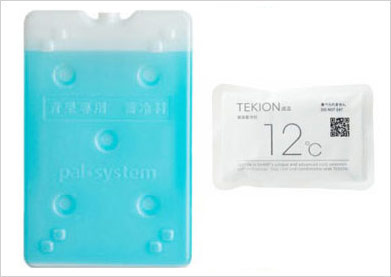
Right: 12°C Tekion cold-retention material for the Core Cooler
- *1
- For cold-retention material (refrigerant) for cooling shipped fresh produce. As of August 3, 2020; based on Sharp research.
- *2
- Based on nationwide fact-finding survey estimating CO2 emissions from households (October 2014–September 2015) (CO2 emission coefficient), and 2018 figures for CO2 emission coefficient by power producers (for calculating greenhouse gas emissions from specified emitters) (CO2 emission coefficient); both published by Japan’s Ministry of the Environment.
- *3
- Jointly developed by Descente Ltd., Wingate, and Sharp.
2020
8M-B120C 120-inch 8K Display
The 8M-B120C 8K display is a commercial-use information display with a 120-inch-class 8K LCD panel, among the largest in the industry*. The 2,657.2-mm x 1,494.7-mm (W x H) large screen gives realistic reproduction of everything from the texture of materials to the depth of scenery.
The 8M-B120C employs imaging technologies developed for the AQUOS 8K TV, allowing full-high-definition and 4K-resolution images to be upconverted to 8K for clear, detailed images, and direct-lit LED local dimming technology for better display of lights and darks. It also comes with an HDMI 2.1 port for 8K content.
The 8M-B120C features the multi-screen input needed for commercial usage, so users can show several different kinds of content at once. Four PCs can be connected using a video cable and their images shown on a four-part split screen on the 8M-B120C. Each image can be relocated on the screen and even enlarged or shrunken in size.
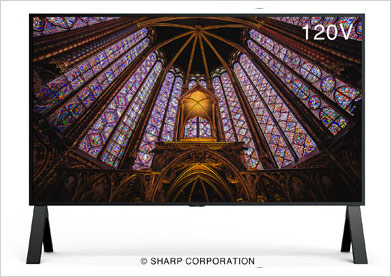
- *
- For displays using an 8K LCD panel. As of September 9, 2020; based on Sharp research.
2020
Face Shield, Eye Shield, Mouth Shield
In cooperation with Issei Oura, product designer and representative director of the NPO Mamoru wo Mamoru, Sharp has released a face shield, eye shield, and mouth shield to protect against airborne droplets. These high-performance products are made of a comfortable-to-wear and highly durable titanium frame*1 and a film utilizing special surface processing technology (Moth Eye technology) built up through Sharp’s LCD panel development.
Both sides of the clear film are specially processed (using Moth Eye technology) to cut surface reflection and thus dramatically reduce*2 glare. Besides preventing reflected sunlight and room lighting from obstructing the wearer’s view, the shields use a special newly developed acrylic resin that is effective in preventing mask fogging caused by high humidity or the user’s exhalations. The result is a consistently clear field of view.
The shields incorporate a light titanium frame made in Sabae, Japan’s most renowned eyeglass-manufacturing district, giving a shield that is comfortable to wear, even for long periods. The surface of the film is highly resistant to scratching, so each one has an exceptionally long service life.

- *1
- The FG-F10M face shield uses a polycarbonate frame.
- *2
- Surface reflectivity is approximately 0.3%.
2021

2021
3°C Tekion Cold-retention Material
Using technology derived from our research into LCD materials, Sharp developed 3°C Tekion cold-retention material for use in shipping pharmaceuticals at cold temperatures. The cold-retention material is used in a constant-temperature transport container set developed in collaboration with—and sold by—Sugiyama-Gen Co., Ltd. This innovation makes it more efficient to transport pharmaceuticals at a constant temperature.
Transporting pharmaceuticals requires strict temperature control. Specimens, vaccines, and cells must be stored at temperatures between 2 and 8°C, while blood needs to stay within a range of 2 to 6°C. Sharp’s 3°C Tekion cold-retention material works for both temperature ranges.
When using the constant-temperature transport container sets, there’s no need to make seasonal cold-storage temperature settings or change the composition of cold-retention material packs. The unique features of the 3°C Tekion cold-retention material make such steps unnecessary.
Conventional constant-temperature transport containers require one to two hours of waiting time until their frozen cold-retention material reaches an appropriate temperature. Utilizing Sugiyama-Gen’s know-how has made it possible to place 3°C Tekion cold-retention material inside the container right after the material has been taken out of the freezer. This eliminates any waiting time before packing, thereby boosting operational efficiency. The constant-temperature transport container set is the first such product in the industry* that can be used consistently throughout the year with zero waiting time.
Based on the constant-temperature transport container sets, Sharp jointly developed a product specifically designed for transporting COVID-19 vaccines. The 3°C Tekion cold-retention material marked Sharp’s entry into the field of constant-temperature pharmaceutical transport.
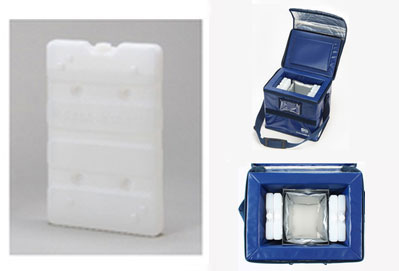
Right: Constant-temperature transport container set using 3°C Tekion cold-retention material
- *
- For constant-temperature transport container sets using cold-retention material for shipping pharmaceuticals. As of December 24, 2020; based on Sugiyama-Gen findings.
2021
AQUOS R6 Smartphone
Sharp released the AQUOS R6 “co-engineered with Leica” smartphone as the first fruits of a collaboration with Leica Camera AG, a company that has been making camera history for over a century.
Sharp and Leica jointly developed the entire camera system. This included the design of the sensor and lens as well as image quality adjustments. The result is a 1-inch sensor—among the world’s largest for smartphones*1—and a Leica-branded Summicron 7-lens unit (f/1.9, focal length 19 mm).
With high sensitivity for effectively capturing light even in dark settings, the R6 can take distortion-free images across the range from wide angle to telephoto. And by incorporating computational photography—a digital image-processing technology—the R6 can, with high sensitivity, shoot superb images with a wide dynamic range, day or night.
The display is a Pro IGZO OLED, the world’s first*1 OLED display with a variable refresh rate of 1 Hz to 240 Hz*2. The display automatically switches refresh rates in real time to suit the content, achieving both superb energy efficiency and clear, smooth images with minimal image persistence.
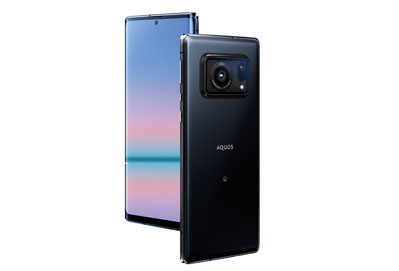
- *1
- For smartphones. As of May 17, 2021; based on Sharp findings.
- *2
- When you set up the device for gaming, the R6 alternates a black screen with each screen refresh 120 times per second—achieving a refresh rate of 240 Hz. This is four times the speed of when the display is set at OFF (onscreen image updated 60 times per second). The refresh rate range will differ depending on display conditions and state.
2021
MH-L1-B Medical Listening Plug
Sharp released the MH-L1-B Medical Listening Plug, a wireless earphone-style hearing aid for users with light or moderate hearing loss. This grew from a collaboration with Neuroceuticals Inc., a medical device manufacturer and seller.
Certified as a “controlled medical device,*1” the MH-L1-B offers all the functionality, quality, and safety of a standard hearing aid at an affordable price*2.
The Medical Listening Plug works with the Cocoro Listening*3 smartphone-based support service. Through this service, hearing aid professionals*4 provide consultations and after-sales assistance. From the comfort of their own homes, users can chat with support staff over video and get help with initial set-up and later fine-tuning of their devices.
The MH-L1-B allows users to make settings*5 to match common usage scenarios, such as online meetings, customer service, or commuting. It can also be used for listening to music in high quality, just like with wireless earbuds. A built-in microphone allows hands-free calls on a smartphone.
With a stylish design that matches any business setting, the MH-L1-B was launched as a new class of hearing aid that people would want to wear daily, just like eyeglasses or a wristwatch.
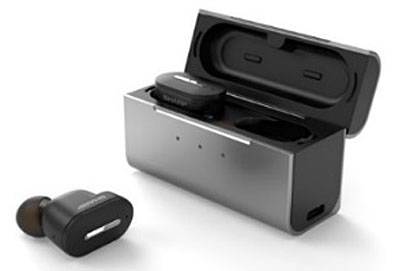
- *1
- Manufacturer and seller: Neuroceuticals Inc. Medical device certification number 303AFBZX00058000.
- *2
- Compared to a typical purchase price of 300,000 yen for a pair of hearing aids. (Source: JapanTrak 2018 survey report)
- *3
- To use Cocoro Listening, you need to download an app and have a Cocoro Member ID. The hearing aid fitting support service, which includes remote hearing tests and hearing adjustments, is free of charge for 60 days after product purchase. Follow-up services are also available (for a fee).
- *4
- Fitters having qualifications as a certified hearing instrument technician or speech-language-hearing therapist, or dedicated fitting staff members.
- *5
- Settings can be made for 10 individual scenarios. Up to four settings can be registered in the main unit.
2021
MA-C20V1/C2015 Nonwoven Sharp Crystal Masks
The Sharp Crystal Mask has a three-dimensional form based on a hexagonal shape (dubbed 3D Crystal*). This design gives a more flattering profile to the face and ensures ample space around the mouth. This makes it easier to breathe and minimizes smudging of makeup and lipstick.
Hygiene-wise, the mask uses a four-layer nonwoven filter that blocks more than 99% of PM2.5, pollen, particulates, and virus-carrying droplets. The outermost nonwoven layer is impregnated with an inorganic antibacterial agent that inhibits the growth of bacteria on the mask surface through the action of silver ions (Ag+).
Since March 2020, Sharp has been offering face masks manufactured in the clean rooms of its Mie Plant as one way to contribute to society. The MA-C20V1/C2015 masks were released as premium products to wide acclaim, combining style, comfort, and function.
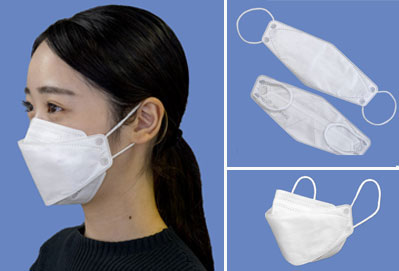
- *
- The mask’s shape resembles a hexagonal rock crystal. That’s why Sharp calls its shape 3D Crystal.
2021
DX1/DP1 AQUOS XLED 8K/4K TV
The AQUOS XLED DX1/DP1 8K/4K TV was launched as a new brand under the AQUOS lineup. It employs newly developed mini LEDs for its backlight.
The 4T-C65DP1 has approximately 72 times the number of mini LEDs compared to previous models*1, in a highly concentrated array. Newly developed active mini-LED drive technology allows fine control of the darkness and brightness levels in each area of the screen. This technology has dramatically improved contrast and other display performance parameters.
Peak brightness of the 4T-C65DP1 is roughly three times that of previous models*1. This allows viewers to enjoy dynamic images ranging from dazzling brights to sharp blacks. Newly adopted Quantum Dot*2 Rich Color technology converts the optical wavelength of the backlight to produce pure primary colors (red, blue, and green). This results in a wide color gamut and vivid color reproduction.
On the audio side, Sharp has revamped the speaker system. The newly developed ARSS+ (Around Speaker System Plus) audio system places speakers not only at the bottom of the screen, but also on the top and sides*3. This system creates an immersive sound field, putting viewers right in the middle of the action, where sound and images come alive as one.
The DX1 line features a “floating display” design with an ultra-thin bezel of just 2 mm. With just 2 mm between the screen and the background, onscreen images appear to float in mid-air.

- *1
- Comparison with the Sharp 4T-C65DN1 4K LCD TV (released in 2021). The new 4T-C65DP1 has roughly 8,000 mini LEDs. The number of mini LEDs in an 8K TV will differ.
- *2
- This technology converts the wavelength of the blue light emitted from the backlight by using a quantum dot filter to achieve rich color reproduction more efficiently.
- *3
- Side speakers are for the DX1 line only. The DP1 line has speakers at the bottom and top of the screen.
2022

2022
TEKIjuN Humidity Control Material
TEKIjuN is a world first*1, a humidity control material in solid form that adjusts airtight spaces to a desired humidity, and maintains them*2, by absorbing moisture when the air is humid and releasing moisture when it is dry. The balance of ingredients of TEKIjuN can be changed to allow it to achieve and maintain a target relative humidity of anywhere from 40% to 90%. Besides allowing maintenance of a humidity environment at a level ideal for stored items regardless of outside temperature, TEKIjuN comes in solid form—resin infused with liquid moisture control material—to eliminate the risk of leakage and make it easy to handle. It also requires no power source.
TEKIjuN comes in bead and sheet form. The beads are able to absorb and release large amounts of moisture and are effective over long periods. This makes them suitable for storing things like industrial and art items, luxury goods, and food. The sheets can rapidly absorb and release moisture and react to extreme fluctuations in humidity, making them ideal for use as anti-condensation material for electronic equipment, buildings, and logistics.
In fiscal 2022, Sharp released bead-type TEKIjuN for quality control of upright pianos and storage at research institutions.

- *1
- According to Sharp (as of January 20, 2022).
- *2
- There may be a relative humidity change of a few percentage points with changes in outside temperature, but over time humidity will approach the desired level.
2022
AN-SC1 AQUOS Sound Partner
The AN-SC1 AQUOS Sound Partner wearable AI speakers connect to Wi-Fi and allow the use of voice assistant features without the need to connect to a smartphone or other device. It uses the Amazon Alexa*1 cloud-based voice assistant from Amazon.com, Inc. Through interaction with the voice assistant, users can listen to news and music and search information from a range of locations*2, as well as use voice commands to operate appliances, lighting, and other voice-enabled devices*3.
Like with previous Sound Partner models, the AN-SC1 can connect via Bluetooth to TVs, smartphones, and PCs for wireless enjoyment of, for example, audio from TVs and music from smartphones. Its built-in microphone allows it to be used for videoconferences over PCs.
The market release of the AN-SC1 is thanks to an autumn 2021 crowdfunding campaign on Green Funding, which raised more than nine times the target amount.
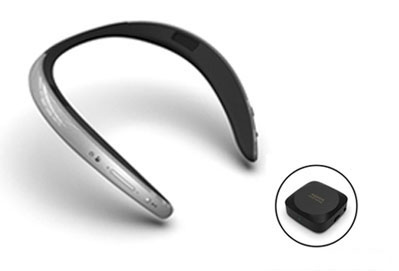
Right: Bluetooth transmitter (bundled)
- *1
- Note that certain of the Amazon Alexa services for things like phone calls, alerts, announcements, and message-sending cannot be used.
- *2
- Only in locations with Wi-Fi available.
- *3
- Amazon Alexa voice-enabled devices. The product is not guaranteed to work with all devices and functions. Connection set-up may differ depending on the voice-enabled appliance being used. A hub (sold separately) may also be needed for Wi-Fi connection.
2022
Medicated Crystaliq Skincare Products
With masks being worn on a daily basis and creating new skincare concerns, Sharp has responded by entering the skincare field and launching medicated Crystaliq products on the online COCORO Store.
The inaugural lineup comprises three products: BE-Q100C moisture cream, BE-Q100T moisture lotion, and BE-Q100L moisture emulsion. The products contain a water-retaining active ingredient called heparinoid to retain the skin’s moisture, thus preventing dryness and promoting moist, healthy skin. An anti-inflammatory ingredient called dipotassium glycyrrhizinate prevents rough skin and acne.
Added to the lineup are BE-Q100U UV brightening cream, which blocks ultraviolet rays and blue light to suppress wrinkles and keep skin even-toned; and BE-Q100W, a foaming facial cleanser that contains ingredients to fight bacteria and inflammation and thus prevent acne.
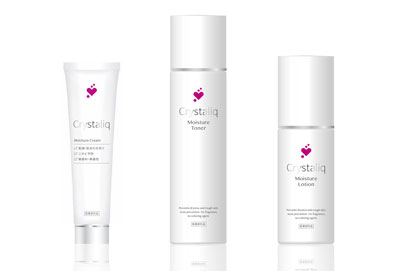
2022
LC-LH Indoor Photovoltaic Device
Sharp has developed the LC-LH indoor photovoltaic device, the result of a fusion of technologies for dye-sensitized solar cells*1 and liquid crystal displays. It boasts high conversion efficiency even in weak indoor light and can be mass-produced at significantly low cost and high quality using existing LCD production facilities and know-how. Its combination with a range of devices will result in the creation of environmentally and people-friendly products that eliminate the need for wiring and the need to use, change, and dispose of batteries.
The LC-LH won the Minister of Economy, Trade and Industry Award, one of the highest honors in the CEATEC Awards*2 at CEATEC 2022, Japan’s largest IoT exhibition (held in October 2022).
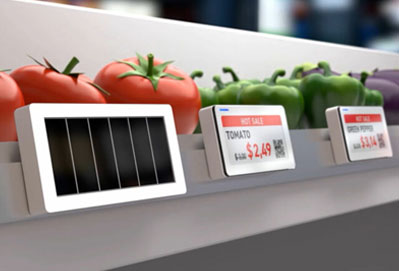
- *1
- A type of organic solar cell that converts light absorbed by dyes into electricity.
- *2
- In the CEATEC Awards, a panel of judges assesses, selects, and commends technologies, products, and services displayed at the CEATEC exhibition that are highly innovative and superior from an academic and technological perspective and from the point of marketability and future potential.



